

Trouble Keeping Her Green: Creating the Orions

The Orions were among the first alien species introduced in Star Trek . A slave girl, or rather the illusion of one, was played by Susan Oliver in the ill-fated pilot episode “The Cage”.
The “green girl” was the creation of Fred Phillips, who also made Spock’s Vulcan look for The Original Series . Stephen E. Whitfield and Gene Roddenberry recalled in The Making of Star Trek how Phillips grew increasingly frustrated as three consecutive makeup screen tests, in which Roddenberry’s future wife Majel Barrett had been painted green, came back negative.
Now, Fred Phillips is an exceptionally fine makeup artist and recognized as a top pro in the business. He did a thorough job with the makeup and was quite satisfied with the results. Imagine everyone’s surprise, upon viewing the developed film the next day, to find the actress’ face just as normally pink skinned as ever! There was no trace of green.
Gene’s orders to Fred Phillips: “Paint her greener!” The following day, the test film again showed her as pink-skinned as ever. Even Fred was dumbfounded.
We did this three days in a row. We had her so green you couldn’t believe it and she kept coming back pink! Finally we figured out what was happening. The technician over at the film lab would receive the film every day and run it through the development solution. As the image formed on the film, he kept saying to himself, “My God, this woman is green!” And so he kept correcting the film developing process in order to turn her back to normal skin color again!
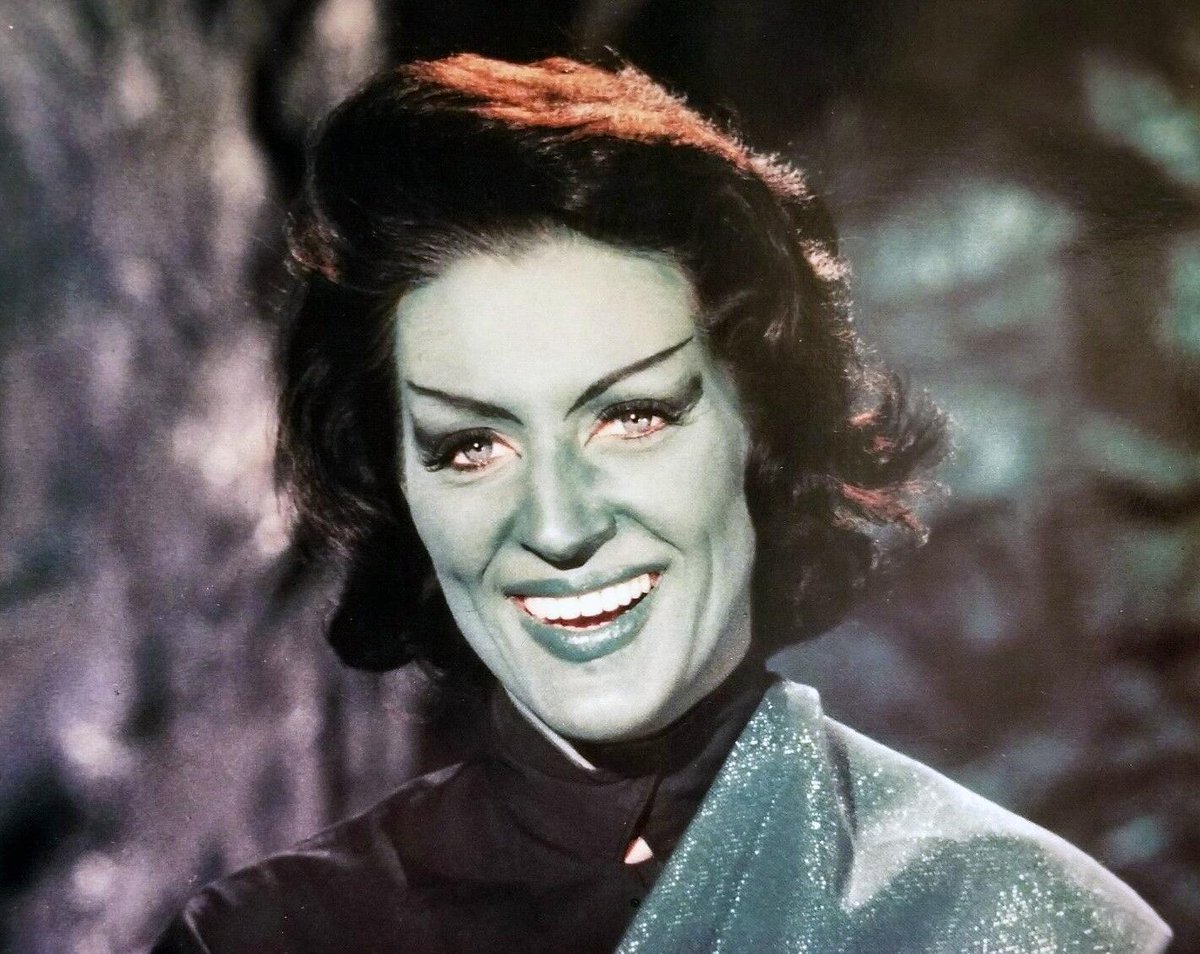
Whitfield and Roddenberry shared another amusing anecdote about the shooting:
The accomplished actress Susan Oliver later played the part of the alien woman in the pilot and was almost totally covered with green body makeup. During filming she became very tired and a doctor was called in to give her a vitamin B shot. The doctor arrived, but no one bothered to tell him what his patient looked like. He went over to Susan’s dressing room, knocked, the door swung wide and suddenly he was confronted with an all green woman! He was so flustered that it took him almost 5 minutes just to find a spot to administer the shot.
The Season 2 episode “Journey to Babel” featured another Orion, although he was disguised as an Andorian. It was not until “Whom Gods Destroy” that a genuine Orion female appeared on screen. The first Orion male appeared in “The Pirates of Orion” of The Animated Series .
While references were made the “Orion Syndicate,” a criminal organization, throughout Star Trek: Deep Space Nine , it wasn’t until the fourth and final season of Star Trek: Enterprise that the Orions reappeared. But they reappeared in plenty then.
I believe you’ve mistaken Phillips with John Chambers, who was the head makeup artist on Planet of the Apes , and who worked with him on The Outer Limits and on “The Cage” (designing Spock’s ears). Phillips wouldn’t have time to work on POTA anyways, as it was shot simultaneously with the second season of Star Trek .
Submit comments by email .
T’Pau and L’Rell: Comparing Representations of Alien Women in Power
Kaja gjelde • september 29, 2020.
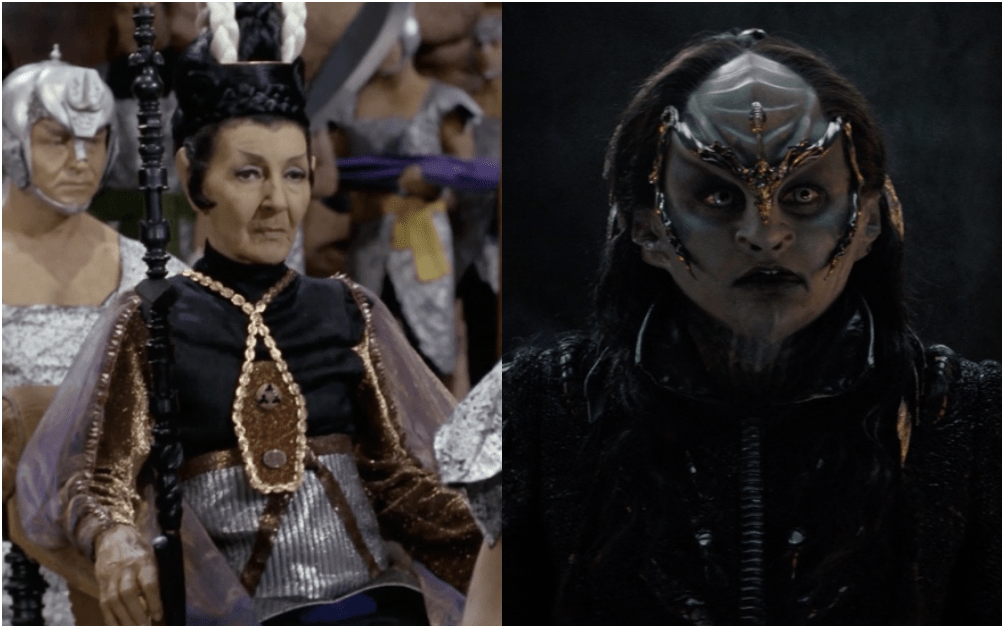
T’Pau making her first appearance in season 2 of Star Trek: The Original Series, played by the talented Celia Lovsky (left), and Chancellor L’Rell portrayed by the incredible Mary Chieffo in Star Trek: Discovery season 2 (right)
Arguably, one of the most important functions of science fiction as a genre is its ability to construct future realities uninhibited by current technological limitations and social inequalities. Madeleine Clark recently published a thought-provoking article on The Mary Sue titled, “ Why Captain Janeway Still Feels so Relevant 25 Years After Going Where no Woman has Gone Before .” Clark poses a simple yet poignant answer to her titular inquiry, “there’s something really exciting about seeing women characters for whom gender is never an obstacle to overcome.” Janeway exists in an imagined future where sexism does not exist as it does today, decades after Voyager premiered. This prompted my own reflection on women in positions of authority in Star Trek and to what extent they embody this gender-equal future.
Women at Warp has discussed this subject in depth, especially in episodes focused on Janeway and other women captains in Starfleet. For this blog post however, I examine the representation of women in power within alien societies that are not portrayed as gender-equal in the future, namely T’Pau and L’Rell.
T’Pau of Vulcan
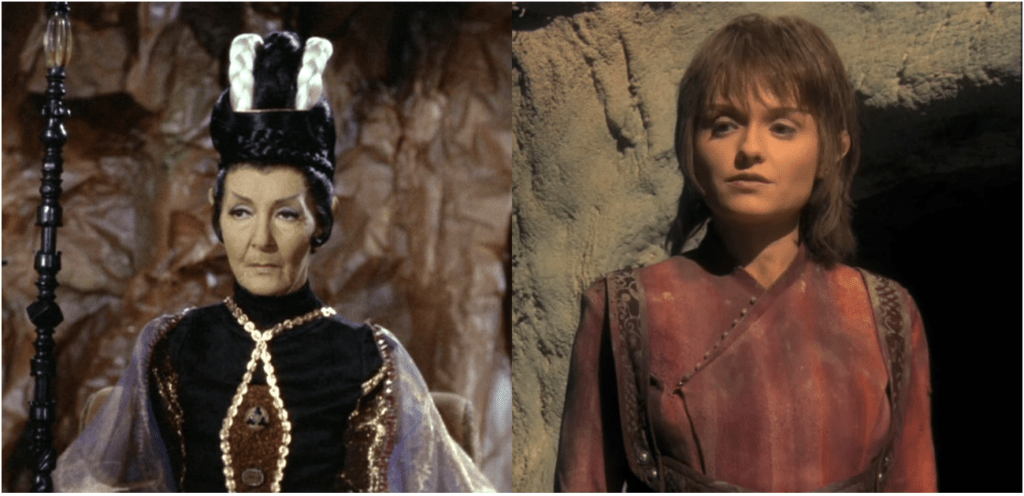
Originally played by Celia Lovsky (pictured left) in TOS, T’Pau is initially presented as a highly revered leader of a planet that values logic above all, but who also reinforces ancient gender roles that seem outdated, particularly from a feminist perspective. Later in Enterprise, Kara Zediker (pictured right) portrays a younger, more rebellious version of the character
Making her first onscreen appearance in The Original Series (TOS) episode “Amok Time,” T’Pau is presented as a prominent political and respected social figure in Vulcan society. Awestruck by her presence, Captain Kirk admiringly relays her accomplishments to Dr. McCoy and states she is the only one to have turned down a seat on the Federation Council. In the episode, Kirk and McCoy witness Spock’s marriage ceremony officiated by the great T’Pau herself. Emphasizing its importance to Vulcan society, T’Pau explains this Vulcan tradition, “comes down from the time of the beginning without change. This is the Vulcan heart. This is the Vulcan soul. This is our way.” During the ceremony, T’Pring, Spock’s intended, invokes her right to initiate the Kaliffee, or ritual combat to the death. T’Pau asks T’Pring first to choose her “champion” to fight Spock, and then inquires if she is ready to become the “property of the victor.” (Icky!) Overall, T’Pau is initially presented as a wise, mysterious authority figure who not only values Vulcan culture and tradition but also is clearly entrusted with protecting it.
In Enterprise , a prequal series to TOS , a younger version of T’Pau leads a minority of Vulcans called Syrrannites, who follow a particular pacifist interpretation of Surak’s teachings. During a three-part story arc in season 4, T’Pau is instrumental in disbanding the corrupt High Command and remains a prominent figure in the ongoing sociopolitical reform on Vulcan afterwards. Evidently T’Pau plays a significant role in shaping the Vulcan society viewers have come to know and love. The only drawback, at least for the feminist in me, is that T’Pau also uses her authority to uphold ancient Vulcan traditions, such as the institution of marriage where women are regarded as property. After taking down a corrupt, seemingly male-dominated government (at least in-universe), T’Pau stays true to Vulcan tradition later when she officiates Spock’s wedding ceremony to continue a practice that has been conducted in this fashion since time immemorial.
Chancellor L’Rell of the Klingon Empire
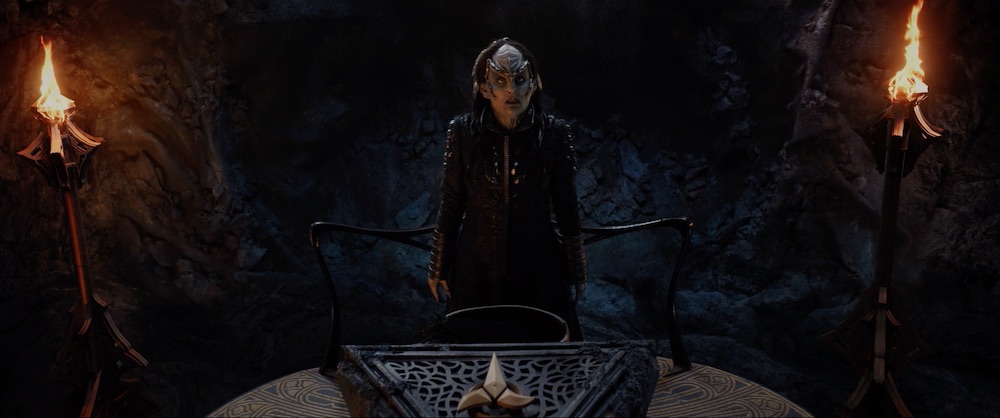
Chancellor L’Rell declares herself the Mother of All Klingons.
Another example of a powerful women character breaking some gender norms while upholding others is Chancellor L’Rell from Star Trek: Discovery . Mary Cheiffo’s riveting performance as L’Rell illustrates a woman’s rise to power in a role previously dominated by men. During Virtual Trek Con’s “ The Influence of Strong Women in Star Trek ” panel, Chieffo compares L’Rell to other historical rulers like Queen Elizabeth I and Hatshepsut, who had to navigate a male dominated society. Through insights into Klingon culture provided mainly by The Next Generation and Deep Space Nine , the Klingons clearly have a robust patriarchal society bolstered by values of honor and courage in combat in which primarily men take part. Klingons are arranged into familial units called houses, which the women seemingly run but cannot lead nor can they represent their house on the Klingon High Council. In short, Klingon women have greater social agency in the private sphere while men dominate the public sphere. After viewing a great deal of Star Trek in preparation for her role as L’Rell, Mary Chieffo states that “Their [Klingon women’s] responsibility and their power is in the house, which is a totally respectful thing to be, but that was definitely a key to L’Rell’s character from the get-go she was not that. She was a commander, so she was already an outlier.” From when Discovery viewers first see L’Rell on the bridge of T’Kuvma’s ship, she is already challenging the gender norms of her society. Referring to L’Rell’s self-ascribed role of Mother to the Klingon Empire, Chieffo compares her character’s rise to power to Elizabeth I’s historical ascension to the throne as the Virgin Queen referring to, “the way in which so many women have had to create an archetype for themselves in order for people to listen to them. I find L’Rell’s plot very tragic throughout, but powerful and empowering… but she is so set on upholding her culture.”
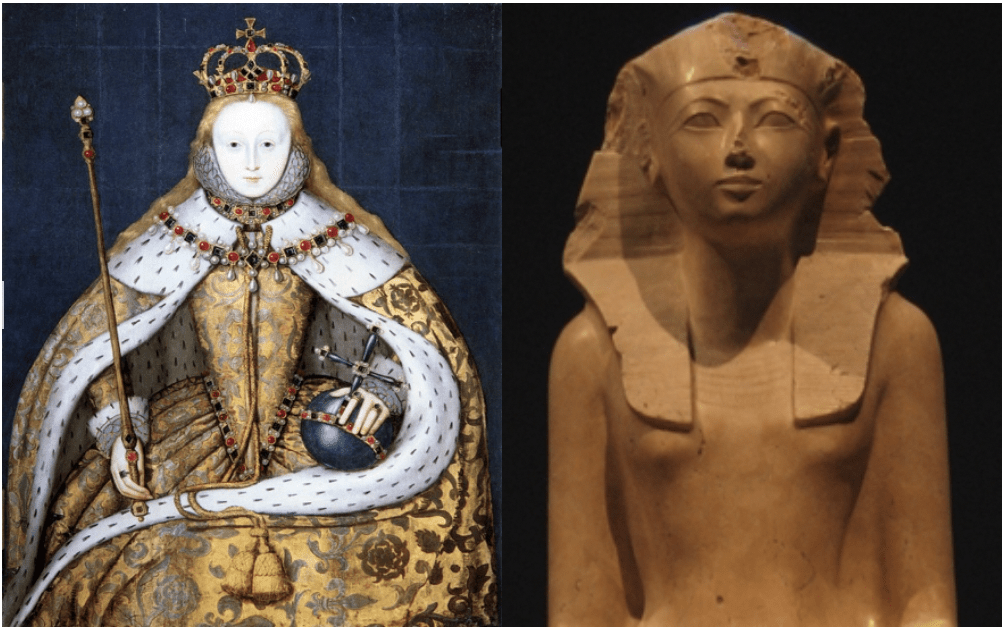
Portrait of Queen Elizabeth I, also known as the Virgin Queen, in her coronation robes (left) and statue of Hatshepsut on display at the Metropolitan Museum of Art (right).
Asserting her authority, Chancellor L’Rell gives herself the title of Mother of all Klingons in “Through the Valley of Shadow’s.” Even L’Rell’s costuming reflects this more traditional maternal archetype. L’Rell goes from wearing formidable full-body armor like all the other warriors in the first season, to a floor-length gown in the second season. Chieffo describes how this was intentionally executed behind the scenes,
I did end up being much more “feminized” in the second season… I felt [it] made sense within the plot, within this patriarchal world that as chancellor she had to subscribe to the norms more and that was part of [what] Gersha Phillips,’ our incredible costume designers,’ conceded was that aside from just wanting to give me fun fabulous outfits, the fact that I did have cleavage and there was the notorious Klingon boob-window. All these things that we have seen in the past for how these women have been sexualized in good or bad ways: how is L’Rell trying to grapple with that as a leader? And ultimately within the Madonna/whore dichotomy leaning more towards actually the mother, which kind of falls in between.
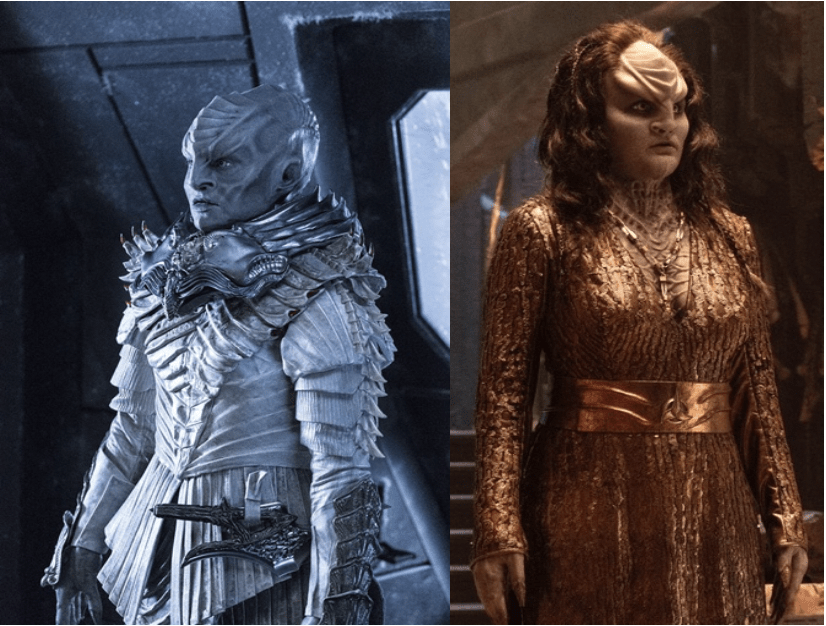
L’Rell as an armor-clad commander in T’Kuvma’s house in Discovery season 1(left), and a “feminized” image of her as chancellor in season 2 (right).
While L’Rell’s invocation of the role of “mother” is powerful, it bears further consideration as to why a woman leader must legitimize her authority by framing it within a traditionally feminine role.
T’Pau and L’Rell’s Legacy
From her first appearance in TOS, T’Pau continues to be a respected leader in Vulcan society as her legacy is brought up in other iterations of Star Trek . However, L’Rell’s legacy is unclear. Although Discovery was written more recently, canonically it is apparent from other iterations of Star Trek that the Klingon patriarchy reasserts itself after L’Rell’s reign. Like how Pharaoh Hatshepsut’s successor tried to destroy all records and images of her after her death, Chieffo posits L’Rell’s name does not come up in Klingon history in-universe because her successor wanted to consolidate his power by erasing and/or delegitimizing L’Rell’s rule. Though L’Rell’s rise to power is unprecedented, L’Rell ultimately upholds her cultural heritage as chancellor and seemingly does not challenge the Klingon patriarchy to, for instance, try to elevate the status of other Klingon women during her reign.
Similarly, T’Pau breaks Vulcan norms by being a woman leader who (as far as we know) is not married, and who promotes a great deal of social and political reform by normalizing previously stigmatized practices, like mind melding. T’Pau values her cultural heritage and uses her position and influence to uphold ancient (some could say sexist) Vulcan traditions. Accordingly, T’Pau’s portrayal as an effective revolutionary and competent political reformer gives viewers a strong example of a woman leader who is also a nuanced character, promoting both diversity as well as upholding tradition in Vulcan society.
In comparing these two women characters, it is worth emphasizing that they are alien and therefore represent an “other” for a human audience. Near the end of the Virtual Trek Con panel, Chieffo cautions against judging alien women characters based on our own contemporary human standards. Just as Captain Janeway’s character allows current viewers to imagine a future where gender does not affect women in positions of authority, these alien cultures effectively hold a mirror up to our past and current realities where sexism persists. On one hand perhaps we shouldn’t hold fictional alien cultures to our own standards, but on the other it would be foolish to not remain critical of the structural inequalities illustrated in fiction and how they represent or fail to faithfully depict real people’s lived experiences. As a truly dynamic genre, science fiction allows for both an exploration of future possibilities as well as an invitation to investigate the world as it is now.
Post navigation
1 comment for “ t’pau and l’rell: comparing representations of alien women in power ”.
I LOVE THIS!
Leave a Reply Cancel reply
Your email address will not be published. Required fields are marked *
The Eye-Catching Women of Star Trek the Original Series
Star Trek: The Original Series is known for being a trailblazing sci-fi series that boldly explored a broad range of themes, including technology, politics, civil rights, sexism, racism, and a plethora of other social issues. Despite not initially getting the attention it deserved, it proved to be a revolutionary show that gave birth to a franchise that has endured for more than half a century now.
From the beginning, Gene Roddenberry, the creator of the series, strove to use his platform as means to express his beliefs and convictions. While some might look back at the female cast members of Star Trek as merely being eye candy, in truth, Roddenberry’s goal was to depict women as being strong, empowered individuals who could hold their own just as well as any of the boys could.
That being said, there’s no denying the fact that many of the women who appeared on Star Trek: The Original Series, both in main and guest roles, were incredibly attractive. From the late Nichelle Nichols as Lieutenant Uhura to Majel Barrett as Nurse Christine Chapel and Grace Lee Whitney as Janice Rand, join Facts Verse as we take an indepth look at The Eye-Catching Women of Star Trek the Original Series.
Nichelle Nichols – Nyota Uhura
Nichols portrayed Nyota Uhura in Star Trek: The Original Series and it’s film sequels. Her addition to the show’s cast was seen as being very groundbreaking for African American actresses on American TV at the time.
She was born in Robbins, Illinois, on December 28, 1932. It was in Chicago that she got her start as a model, dancer, and singer. She eventually moved on to stage acting before being cast in film and television roles.
In 1959, Nichelle appeared as the principal dancer in the film adaptation of Porgy and Bess. Prior to being cast as Uhura on Star Trek, Nichols was a guest star on Gene Roddenberry’s first TV series, The Lieutenant, in the 1964 episode To Set It Right.
On Star Trek, her prominent supporting role as a bridge officer on the USS Enterprise was unprecedented. Being one of the first Black women featured on a major network series was seen as a major victory for civil rights activists.
She was tempted to leave the show early on in it’s run, but a conversation with Martin Luther King Jr. convinced her to stick around.
In an episode titled Plato’s Stepchildren, which aired on November 22, 1968, Nichols shared an onscreen kiss with white actor William Shatner who played Captain James T. Kirk. The episode is frequently cited as being the first example of an interracial kiss seen on television in the United States.
After Star Trek’s cancellation following it’s third season, Nichols continued to play an active role in the Star Trek Universe by reprising her role in the Star Trek animated series and several live-action films. She later volunteered with NASA promoting programs aimed at recruiting diverse astronauts.
Nichelle died of heart failure in Silver City, New Mexico on July 30, 2022, at age 89.
Alice Rawlings – Jame Finney
While not a very major role, this astonishingly beautiful actress played the role of Jame Finney in the season one episode ‘Court Martial’.
Before we tell you about several other eye-catching actresses that appeared on Star Trek: The Original Series, take a second to show Facts Verse a little love by giving this video a like and subscribing to the channel.
Andrea Dromm – Yeoman Smith
In the first season episode “Where No Man Gone Before”, Dromm played the character Yeoman Smith. She was actually the second actress to play a captains’s Yeoman, after Laurel Goodwin who portrayed Yeoman J.M. Colt in the first pilot episode “The Cage”.
Dromm was expected to become a series regular, but she only ended up sticking around briefly. Despite being known for using Star Trek to advance his progressive social and political beliefs, director Jimmy Goldstone reportedly overheard Gene Roddenberry say that the only reason why he hired Dromm was because he wanted to ‘score with her’. Needless to say, that never happened.
Decades later, when asked about her time on the show, Dromm said that she had no problems with Gene and thought of him as being a very nice man.
Dromm might have become a recurring cast member if it weren’t for the fact that she was offered a prominent role in ‘The Russians are Coming, the Russians Are Coming’. She was told that she could either do the film or do the series but not both, and she ultimately chose the film. If she had known that Star Trek would become such a phenomenon, she would likely have opted to the series instead.
After Dromm’s departure, her role on the Enterprise was filled by the next actress we’ll be discussing.
Grace Lee Whitney – Janice Rand
Born in Ann Arbor, Michigan, on the first of April, 1930, Whitney began her entertainment career as a singer on Detroit’s WJR radio at 14. After leaving home and moving to Chicago, she opened nightclubs for Buddy Rich and Billie Holiday before touring with Fred Waring and Spike Jones’s bands
She made her Broadway debut in a production of Top Banana. She followed that up by appearing in the 1954 Hollywood film adaption of the play. She went on to appear in more than 100 television roles, including in 77 Sunset Strip, The Roaring 20s, Batman, Hawaiian Eye, and Wagon Train
In 1966, Gene Roddenberry cast her in the role of the third Yeoman, Janice Rand. Whitney appeared in 8 of the first 15 episodes of the series before being released from her contract. She later revealed that while she was still under contract, she was sexually assaulted by one of the show’s executive producers.
Despite that traumatic event, she later reprised her role as Janice Rand in five Star Trek motion pictures. Throughout those films, her character received two promotions – first to the rank of chief petty officer and later to Lieutenant Commander.
To celebrate the 30th anniversary of the Star Trek franchise, Whitney returned in the 1996 Voyager episode ‘Flashback’ alongside her former co-star George Takei. Whitney has also appeared in several fan-made Star Trek productions, including Star Trek: New Voyages and Star Trek Continues.
Angelique Pettyjohn – Shahna
Born Dorothy Lee Perrins, Pettyjohn portrayed the character Shahna in the second season episode, ‘The Gamesters of Triskelion’. And yes, in that episode, she shared a rather passionate kiss with Captain Kirk.
Majel Barret – Nurse Christine Chapel
While Majel Barret has played several roles in the Star Trek franchise including that of Lwaxana Troi on Star Trek: The Next Generation and Star Trek: Deep Space Nine and the voice of the onboard computer interfaces throughout the various Trek series from 1966 to 2009, on Star Trek: The Original Series she played Nurse Christine Chapel.
Barret is also notable for marrying series creator Gene Roddenberry in 1969. Given her unique role and relationship with Star Trek, she is often referred to as ‘The First Lady of Star Trek’.
Majel made her first appearance on Star Trek in the initial unaired pilot episode ‘The Cage’, playing an unnamed Enterprise first officer simply referred to as ‘Number One’. As Nurse Chapel, Barret wore a blonde wig. Chapel was introduced in the sixth episode, ‘The Naked Time’ and proceeded to a be frequently recurring character.
After spending the majority of her professional career dedicated to all-things Trek, having appeared in every incarnation of the franchise in her lifetime, Barret died of leukemia on December 18, 2008, at age 78.
Antoinette Bower – Sylvia
Bower was a German-born actress who portrayed the character Sylvia in the second season episode ‘Catspaw’. Like so many of the other one-off female guest stars on the series, Sylvia too enjoyed a steamy kiss with that shameless playboy Captain Kirk.
Arlene Martel – T’Pring
Hailing from New York City, Martel was best known for playing Spock’s bride-to-be T’Pring in the Star Trek Original Series second series episode Arnok Time.
Throughout her acting career, Martel, sometimes billed as Arlene Sax, was praised for her ability to change up her appearance like a chameleon. She was also renowned for her proficiency with various accents and dialects.
Besides Star Trek, Martel made dozens of appearances on shows like The Man From UNCLE, The Wild Wild West, The Twilight Zone, The Rookies, Perry Mason, Mannix, and The Six Million Dollar Man – just to name a few.
Barbara Babcock
Babcock played several different characters and provided the voices for several more on Star Trek: The Original Series. She can be seen in the first season episodes ‘A Taste of Armageddon’ and ‘Plato’s Stepchildren’.
In addition to portraying Mea 3 and Philana, Babcock also did the voice work for the Beta 5 computer, Isis, Loskene, Zetarians, and Trelane’s mother.
Barbara Baldavin
Baldavin appeared in four episodes of Star Trek; The Original Series.
She portrayed a recurring character named Angela Martine, who can be seen in the episodes ‘Shore Leave’ and ‘Balance of Terror’. She also appeared in the season three episode ‘Turnabout Intruder’, playing the role of communications officer Lt. Lisa.
Barbara Bouchet – Kelinda
Another eye-catching female character that Captain Kirk locked lips with in the season two episode ‘By Any Other Name’ was a blonde named Kelinda, played by Barbara Bouchet.
Throughout her acting career, Bouchet has appeared in more than 80 television shows and films, including 1967s Casino Royal, 1972s The Red Queen Kills Seven Times and 2002s Gangs of New York.
In recent years, Bouchet has mainly appeared in Italian television shows such as Capri, Crimini, and Un posto al sole.
With that, we’re just about out of time, but we’d love to hear from you. Can you think of any other eye-catching beauties that appeared on Star Trek: The Original Series? And who do you think was the most powerful female character to be featured on the series? Let us know in the comments.
If you’ve enjoyed this video, be sure to give it a like and subscribe to the Facts Verse channel.
While you’re at it, tap the bell to turn on notifications. That way, you can keep up with all of our latest and upcoming content as soon as it drops.
As always, thanks for watching. We’ll see you soon with more videos covering some of your favorite Hollywood films, classic television shows, and unforgettable stars.
Written by Alex Carson
Alex Carson is a seasoned writer and cultural historian with a passion for the vibrant and transformative decades of the 1960s and 1970s. With a background in journalism and a deep love for music, film, and politics, Alex brings a unique perspective to the ever-evolving landscape of entertainment.

Cary Grant’s Marriage Crumbled After Affair with Sophia Loren
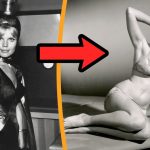
Marta Kristen Confirms the Rumors About Lost in Space Cast

- 2 Mirror universe
- 4.1 Appearances
- 4.2.1 Origins
- 4.2.2 First appearances
- 4.2.3 Reappearances
- 4.2.4 Reception and likenesses
- 4.3 Apocrypha
History [ ]
Talosians were once a warp-capable , technologically advanced culture but a nuclear holocaust left their planet virtually uninhabitable and killed most of the species.
The survivors of the nuclear war congregated in underground dwellings, where they became dependent upon their own mental powers , which they used to create stunningly real illusions, an ability that had been developed by their ancestors. As their mental powers grew, they lost the ability to use the technology left behind by their ancestors.
The Talosians found that life using illusion was addictive, almost like a Human developing a physical and psychological dependence on narcotics . They became bored with the content of the illusions which they had. Their dependence upon these illusions for mental stimuli caused the Talosians to begin capturing space travelers to use as the living basis for their illusions.
In 2236 , the SS Columbia , carrying members of the American Continent Institute from Earth , crashed on Talos IV. All aboard were killed, save for one Human: a badly injured female named Vina . The Talosians repaired her injuries, but their work left her disfigured, as the Talosians were unfamiliar with Human anatomy . Using their powers of illusion, Vina could live as if she was uninjured and was made to appear abnormally beautiful.
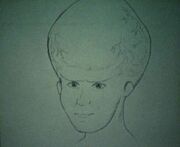
A sketch of a Talosian from the Enterprise 's computer
In 2254 , the Talosians captured USS Enterprise Captain Christopher Pike and attempted to use him to rebuild their civilization. The Talosians hoped that Pike would be attracted to Vina and would wish to remain on Talos IV. Thousands of the Talosians probed Pike's thoughts, discovering he had "excellent memory capacity ." However, after assimilating the records of the Enterprise , the Talosians learned that Humans have a "unique hatred of captivity;" even when made as pleasant as possible, Humans prefer death. This made Humans unsuitable to the Talosians for breeding stock, and Pike and his crew were released.
The Talosians refused Pike's offer of trade and mutual understanding, claiming that Humans would use their powers of illusion to their own destruction, as the Talosians had inflicted on themselves. After Vina's true appearance was revealed, she was given back not only her illusion of beauty, but an illusory Pike to keep her company. ( TOS : " The Cage ")
In 2257 , Christopher Pike's science officer , Lieutenant Spock , began experiencing time non-linearly after an encounter with the being known as the Red Angel . Spock exhibited symptoms of a mental disorder, but was able to repeat the coordinates of Talos IV backwards, which he recalled from his previous visit with Pike. Brought to Talos IV by his adoptive sister Michael Burnham , the Talosians and Vina agreed to help heal Spock, and later assisted in their escape from the planet by projecting illusions on to the Section 31 ship NCIA-93 , making Leland think that he had beamed them aboard while Burnham and Spock had actually escaped in a shuttlecraft. ( DIS : " If Memory Serves ")
This same compassion was again shown ten years later, when the Talosians collaborated with Pike's former science officer, the now- Commander Spock, to bring Pike back to Talos IV (even though Spock's participation in this effort involved defying Starfleet general orders and illegally taking command of the Enterprise ). As Pike was himself a prisoner of his own body after an accident involving delta rays , the Talosians assisted with his return so he could live out the rest of his life virtually free from his useless body. ( TOS : " The Menagerie, Part I ", " The Menagerie, Part II ")
Mirror universe [ ]
In the mirror universe , the Talosians attempted to trick Terran emperor Philippa Georgiou with their mental projections. In response, Georgiou had their civilization 'blasted from the face of Talos IV'. Georgiou noted this to Leland after Section 31 discovered the power of the Talosians to create illusions. ( DIS : " If Memory Serves ")
Appendices [ ]
Appearances [ ].
- " The Cage "
- " The Menagerie, Part I " (archive footage)
- " The Menagerie, Part II " (archive footage)
- DIS : " If Memory Serves "
- LD : " An Embarrassment Of Dooplers " (photograph)
Background information [ ]
Origins [ ].
The Talosians were the first aliens encountered on Star Trek , appearing in the earliest Star Trek: The Original Series production, " The Cage ". (While Spock was the first non-Human featured, his species is not mentioned in that episode.)
Upon devising the Talosians, Gene Roddenberry reused elements of the species from a story outline he submitted for an ultimately unproduced episode of the television series Science Fiction Theater . The story treatment was titled "The Transporter" and featured the invention of a device – the "transporter" referenced in the title – which, in Roddenberry's words, "creates an artificial world for the user, capable of duplicating delight, sensation, contentment, adventure – all beyond the reach of the ordinary person living the ordinary life." The outline also involved the machine's inventor realizing the device might eventually lead to mankind's destruction or, as Roddenberry put it, " [The machine] might be used as they have used the miracle of radio, television, the motion pictures – with more devastating results…. It could create wants and desires for which the world would destroy itself – a dying race sitting at their 'transporters'. " Thus, Roddenberry later made the Talosians capable "of duplicating delight, sensation, contentment, [and] adventure," and established them as a dying race, experiencing life vicariously through others. ( These Are the Voyages: TOS Season One , Chapter 1: "The Creator")
The Talosians were originally written as a crab-like species. The story outline for "The Cage" (as reprinted in The Making of Star Trek , pp. 47-65) commonly referred to them as "crab-creatures" and said of the aliens, " Although in no way Human, they are obviously intelligent and have digital capabilities via six multiclawed arms and legs. " The outline also dictated that, among their own kind, the Talosians were to have used "claw-snap and clatter for speech" and were originally intended to have not only claws but also an "external armor-skeleton" that made similar noises. The aliens were not imagined as being capable of communication, other than the clattering of their claws; the commanding officer of the Enterprise (at that time, known as Captain Robert April ) instead understood the aliens by translating their noises via his "telecommunicator" (a device that later developed into both the common communicator and the universal translator ). Also, the aliens' mode of moving was referred to as "scuttling." ( The Making of Star Trek , pp. 48-49, 58)
Gene Roddenberry discovered crab creatures would be too expensive to build. As a result, the aliens became humanoid. (" The Menagerie, Part I " text commentary , TOS Season 1 DVD ) In the second revised final draft script of "The Cage", the Talosians were thus introduced as " small, slim, pale Human-like creatures with large elongated heads, suggesting huge and powerful brains. They wear shimmering metallic garb. " Roddenberry imagined the aliens as not only thin but also very frail. ( The Making of Star Trek , p. 349)
In a line of dialogue which was scripted for "The Cage" but not included in the final version of that episode (nor any other installment), Pike commented, " What's happened to the Talosians could be sort of a warning, couldn't it. For us individually or for a whole race. Our electronic tape, our viewing screens, even our books, must never become a substitute for real life. " In another scripted but discarded line, Vina said of the Talosians, " Since their minds can reach anywhere, most of them are like cocoons or larvae now. They just sit and let the thought records or some specimen live for them. Some of them hardly move, except to take that blue protein once a day. " This "blue protein" was a reference to the Talosians' protein complex .
First appearances [ ]
The producers and Gene Roddenberry decided to cast the Talosian roles as females and then dub male voices over the footage. In a 1988 interview, Director Robert Butler uncertainly recalled that this idea "might have been" his. He went on to say, " When I saw the characters in the script I thought it would be interesting to get a difference, and one easy difference is to cast women just because of their size and grace, and then add voice-overs later. Therefore you get an oddness, an antisexuality that certainly might be more the case in other galactic cultures than our own, and I think that might have been my notion. But at the same time I remember that when I mentioned it to Gene he had had a similar feeling that we should go bizarre, so there was not much discussion if it was my idea. If I said, 'Hey, let's do that,' he might have said, 'Yeah, I get it, it's a good idea,' or vice versa. " ( The Star Trek Interview Book , p. 97) The idea of casting women, with their lighter builds, appealed to Roddenberry because he thought it might give the impression that the Talosians had let their bodies atrophy in favor of higher brain development. ("The Menagerie, Part II" text commentary , TOS Season 1 DVD ) Thus, Roddenberry searched Hollywood for diminutive actresses who had faces that he deemed to be interesting. ( The Star Trek Compendium , 4th ed., p. 15) Once the performers were cast, their breasts were tightly wrapped, in an effort to disguise each actress' female form. ( The Making of Star Trek , p. 349)
The design of the Talosians additionally incorporated headpieces that – complete with their bulging veins and small, round ears – were created by craftsman Wah Chang and were blended into the actresses' own facial features by Fred Phillips and his make-up staff. ( The Star Trek Compendium , 4th ed., p. 15) Chang's work on the Talosian head prosthetics also included the throbbing quality of veins, but this effect can only be seen on The Keeper 's head. ("The Menagerie, Part II" text commentary , TOS Season 1 DVD ) Meg Wyllie , the actress who played The Keeper, later remembered the make-up required; " The base was an old-fashioned rubber bathing cap – the type with a chin strap. Above, or rather upon the cap, a rubber substance was placed. When that was set, the cap was removed, placed on a form and the technical special effects people finished the skull – placing the blood vessels and covering them. The makeup was not comfortable – my ears especially suffered being so confined under the bathing cap. " ( Starlog issue #117, p. 52) To operate the pulsing veins on The Keeper's head, Assistant Director Robert H. Justman hid out of the camera's line-of-sight and squeezed a small rubber bulb that inflated and deflated the veins. ("The Menagerie, Part II" text commentary , TOS Season 1 DVD ) Sandra Gimpel , who also played one of the Talosians, commented, " Well, the makeup took, like, two and a half, three hours. The interesting part about it is how different it was then from now. The heads. The Talosians talk by telepathy, so the veins would pump every time they talked. So they had an air bladder in the head, with the veins. Then a tube ran down my back and down my arm, and I had a ball in my hand. Every time I pushed it, the air would make the bladder move. That's why you'd see the Talosians standing so still. The costumes had really long arms, because they covered up us holding the ball. " [1]
In an unused line of dialogue from the final draft script of "The Menagerie, Part I", James T. Kirk speculated that the Talosians may have developed "some surgical methods" that the Federation had not yet developed, as of the timing of that episode (in 2267 ). However, Commodore Mendez skeptically replied that the single reference to life on Talos IV in Spock's entire report referred to it as "feeble and parasitic " and that such parasites "hardly make skilled surgeons ."
Reappearances [ ]
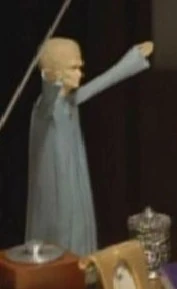
An action figure of a Talosian
A small action figure of a Talosian (a figurine from The Hamilton Collection ) can be seen on Rain Robinson 's desk in the 1996 setting of the Star Trek: Voyager episodes " Future's End " and " Future's End, Part II ". The same or a similar action figure could be found in Production Designer Richard James ' office during production on Voyager . ( Star Trek: Communicator issue 111 , p. 54)
A Talosian appears on the cover of A Child's Garden of Lifeforms in Our Galaxy , a book that was designed by Doug Drexler for DS9 : " Time's Orphan ". ( Star Trek: Deep Space Nine Companion , p. 579)
According to an early script for Star Trek Nemesis , the Talosians discovered B-4 drifting in space. It is likely that Shinzon acquired B-4 from them.
During the making of Star Trek: Enterprise , little consideration was given to bringing back the Talosians, despite other TOS aliens reappearing on the series. Michael Sussman recalled, " To my knowledge, no one on the writing staff was pitching Talosian stories. " ( User talk:Mdsussman#TOS Aliens )
A Talosian was to cameo in the 2009 film Star Trek . It was redesigned by sculptor Don Lanning . He later referred to it as an "amazing design" and speculated that the aliens "would have been played by women." Lanning went on to explain, " I did a drawing that was pretty much a straightforward make-up, where the actor's real neck would be painted green for digital removal, leaving this little spindly neck sculpted onto the front of the actor, and the body would be worn like a Bun Raku puppet. It was a fully realized make-up that was actually rendered out by Joel [Harlow] , and it was a fascinating idea. " ( Star Trek Magazine Special 2014 , p. 137) Harlow crafted the design into a sculpture which featured a paint job by himself and Crist Ballas . [2] Offered Harlow, " What I did was sculpt the head extra-large with a thin neck on top of his real neck. We just assumed that when they shot it, his own neck would have been green-screened out, leaving a giant head on this tiny little neck. I think it would have looked really cool, but it ended up just being a mask, and all the body stuff, which would have been a rod puppet, was sort of neglected at that point. " ( Star Trek Magazine Special 2014 , p. 137)
According to Star Trek: Star Charts (p. 34), the Talosians became warp-capable 500,000 years prior to 2378 .
Reception and likenesses [ ]
Dave Rossi , VFX Line Producer of the remastered version of Star Trek: The Original Series , once enthused about his fondness for the Talosians, " Any aliens that garner the death penalty if you go see them is... They're pretty epic. And it just speaks to their unique power of mind control [....] The Talosians take it [mental powers] to a whole other level. In fact, I would say that, in as far as The Original Series goes, the Talosians are probably one of the most powerful aliens we ever met, and that makes them fun, even though they have fanny heads. " (" The Menagerie, Part I " Starfleet Access , TOS Season 1 Blu-ray ) With similar gusto, Michael and Denise Okuda commented the casting of females as the otherwise male Talosians was "highly creative." (" The Menagerie, Part II " text commentary , TOS Season 1 DVD )
A similar casting trick was used again much later, with the Sphere-Builders in Star Trek: Enterprise , as they were all women except for one male. The same casting strategy was also used in another of Gene Roddenberry's (posthumous) TV series, Earth: Final Conflict , wherein the Taelons (a species that, coincidentally, bear a striking resemblance to the Talosians) were all played by female actors. The Talosians are similar too, in many ways, to the underground mutants of the Planet of the Apes series. Both are subterranean survivors of nuclear disaster with impressive mental abilities, which include the power to create thoughts and images in the minds of others.
Apocrypha [ ]
The novel Burning Dreams reveals that Talosians are androgynous and uses the "s/he" and "hir" pronouns to refer to them. According to the novel, Talosian civilization had been revitalized by the year 2320 thanks to the influence of Christopher Pike. An older novel, Legacy , referred to the Keeper using male pronouns.
In the 1980s DC Comics' Star Trek series, Vol. 1 annual #2, entitled " The Final Voyage ," the Talosians appear when the Enterprise, en route home at the completion of its five-year mission under James T. Kirk , is tricked into returning to Talos IV by Klingons under the command of Captain Koloth . The savage Klingons have taken control of the planet, killed most of the remaining Talosians, and forced the remaining few to teach the Klingons their power of illusion. The Klingons, after delighting in torturing Christopher Pike, force Kirk and crew to relive their entire five-year mission, with their experiences twisted towards their greatest fear. With the help of the remaining Talosians, the crew overcome the Klingons using anger and rage to overcome the illusions, and continue home.
The Talosians of the mirror universe appeared in the short story "The Greater Good" by Margaret Wander Bonanno , contained in the anthology Shards and Shadows . As in the primary universe, they used a distress call to lure the ISS Enterprise to Talos IV with the intention of having Christopher Pike mate with Vina so as to create a race of Terran slaves. However, Pike rejected her, refusing to mate with an "insipid Human female." Upon learning of the Terran Empire fear of telepaths, the Keeper decided to release Captain Pike and use him as their eyes and ears throughout the empire; the captain would give the Talosians an early warning, should the empire ever decide to attack and obliterate their planet. After assassinating Pike and assuming the captaincy of the Enterprise in 2264 , James T. Kirk returned to Talos IV and ordered that its surface be leveled, annihilating the Talosians for the good of the Terran Empire.
- 2 Daniels (Crewman)
- 3 Rules of Acquisition
- More to Explore
- Series & Movies
Published Mar 8, 2023
10 Women in Command Who Paved the Way for Kathryn Janeway
Women lead the way in Star Trek long before Janeway took the captain's chair.
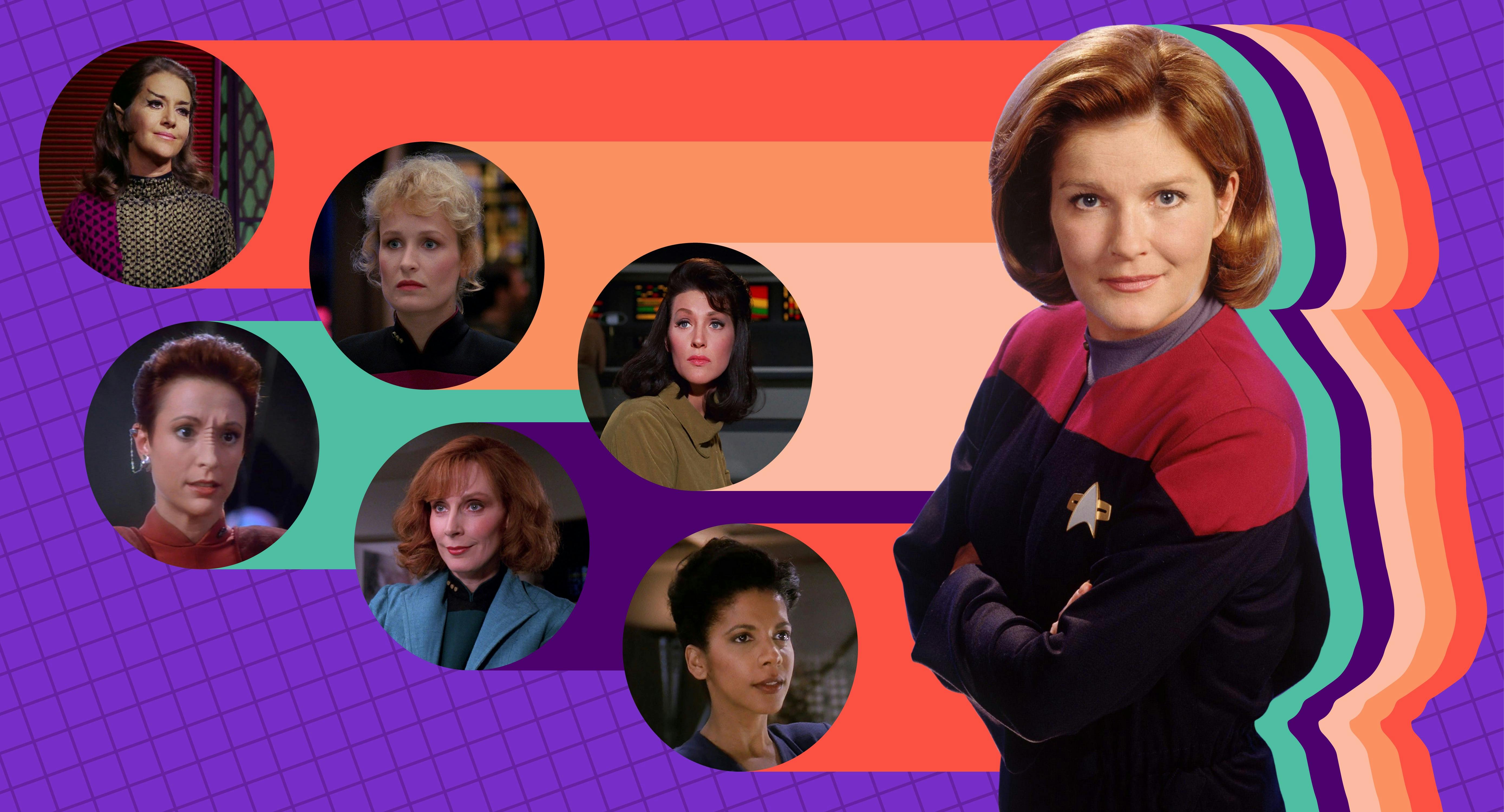
StarTrek.com
Star Trek has long been thought of forward-thinking when it comes to representations of women in positions of power and authority — even before the addition of the trailblazer Captain Kathryn Janeway .
Let’s explore ten representations of women leadership over the first 30 years of the franchise’s history that, for good and ill, paved the way for the 1995 debut of Kate Mulgrew’s intrepid captain.
Number One (Majel Barrett, 1964)
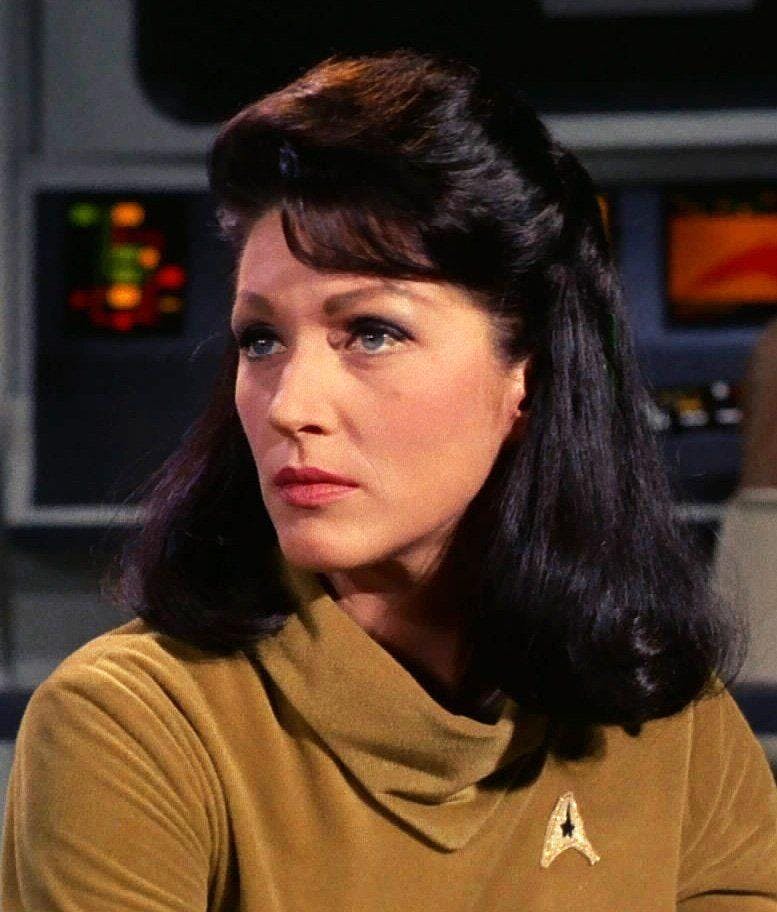
When Star Trek ’s pilot, “ The Cage ,” was first pitched to television executives, Captain Christopher Pike had a woman first officer, known only as “ Number One .” Execs loved the concept of Star Trek , but found the woman first officer not believable. The series was retooled around the Kirk-Spock-McCoy triumvirate and “The Cage” was not shared with the public until the late eighties.
Number One spoke without a whispery, ultra-feminine voice like those adopted by other women characters. Pike granted her “honorary man” status when he said he doesn’t like women on the Bridge, “except for you, Number One.” She was left in charge of the Enterprise while Pike beamed down to Talos IV because “the most experienced officer” was needed on the Bridge. Perhaps, most notably, when Pike was taken captive by the Talosians, we saw all the men in the briefing room look to Number One for a decision about how to approach the situation.
The Romulan Commander (Joanne Linville, 1968)
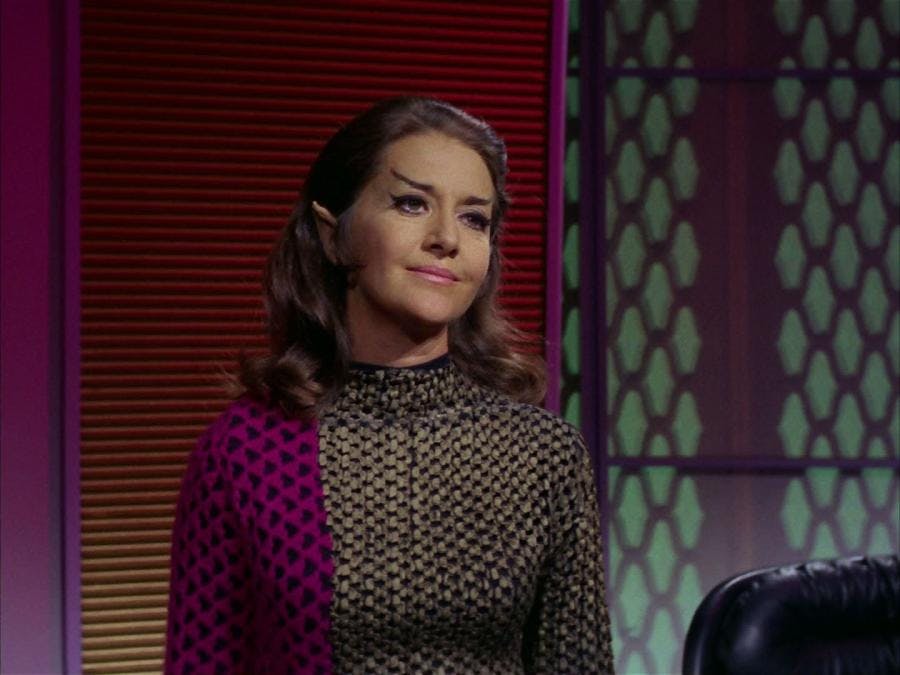
When a seemingly-unstable Captain Kirk takes the Enterprise into the Neutral Zone (“ The Enterprise Incident ,” Star Trek : The Original Series), he and Spock are taken prisoner by a Romulan woman Commander. When we first meet her, she’s fully clothed and visibly older (Linville was 30 at the time) than Kirk’s standard alien babes. Her primary goal seems to be the career win of delivering the Enterprise into Romulan hands, and she initially works to build solidarity with Spock to that end on the basis of shared identity rather than seduction.
Unfortunately, the possibility of getting through an entire episode without turning a woman into a romantic conquest for one of the male leads eluded TOS writers, which is why we ended up with the camera soft-focusing on her face as “the soldier transforms herself into a woman” and whispers her true name into Spock’s ear. When we last see her, she is dressed to the nines and professionally humiliated on the Bridge of the Enterprise . Nevertheless, she made this list as the high water mark in terms of women leadership on The Original Series as it originally aired.
Commander Beverly Crusher, Medical Doctor (Gates McFadden, 1987)
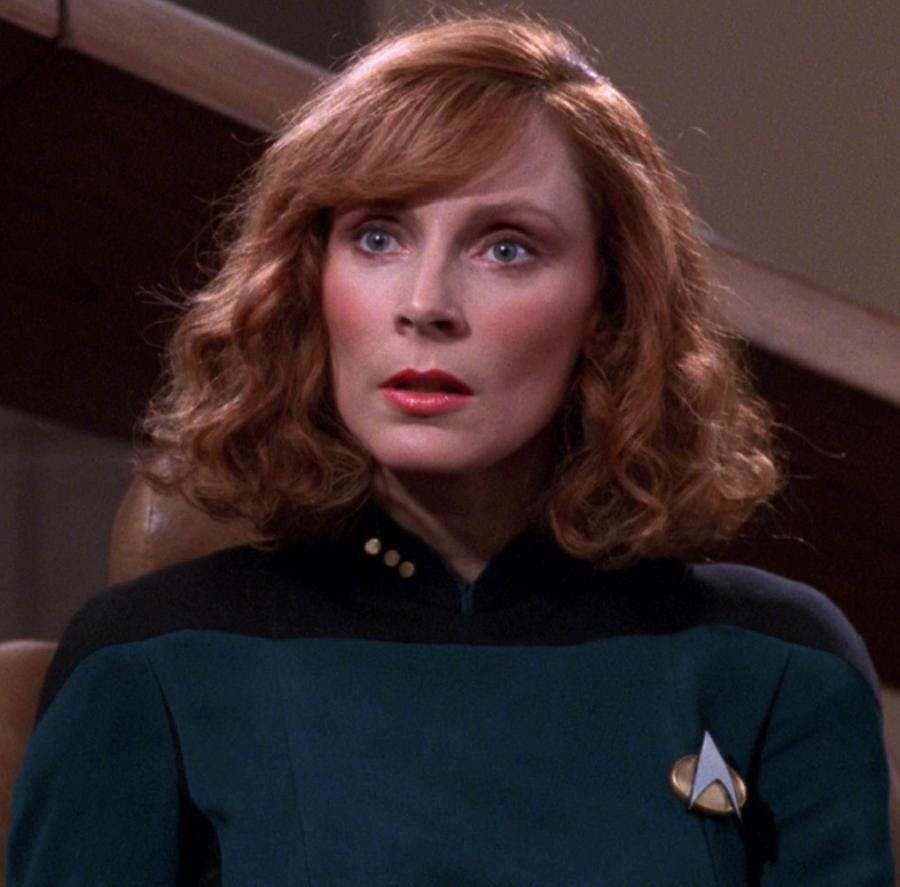
On The Next Generation , the original intention was to have a woman in charge of security, but after Denise Crosby left the show prematurely and her character, Tasha Yar, was killed off, we were left with the two remaining women in positions of caregiving and nurturance.
In later seasons, writers solved this by actually addressing the fact that Dr. Crusher carried the same rank as William Riker and gave her more to do. Crusher brought pluck, initiative, and grace under pressure to every stint she pulled on the Bridge, whether she was stretching herself with the occasional night shift (“ Thine Own Self ”), running the Enterprise solo when an anomaly swallowed her whole (“ Remember Me ”), or fighting off the Borg (“ Descent ”). Which is why it makes total sense that Captain Beverly Picard (she kept the name) of the Federation medical ship Pasteur would call her ex-husband Jean-Luc out after he questioned her orders on the Bridge of her ship (“ All Good Things ”).
Commander Deanna Troi, Mental Health Counselor (Marina Sirtis, 1987)
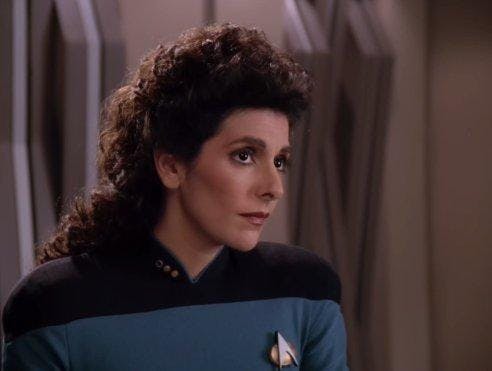
The first time we saw Troi in command on The Next Generation , it’s because she happened to be the most senior officer left alive on the Bridge after the Enterprise hit a quantum filament (“ Disaster ”) and every ship’s system was severely damaged. Overwhelmed and unprepared at first, she found her footing and realized that she likes being in charge.
After returning from a class reunion, Troi caught Crusher finishing up a night shift on the Bridge and they talked about Crusher’s affinity for command. This combination of experiences catalyzed her own desire to take the Bridge Officer’s exam (“ Thine Own Self "). She ran into some trouble with the Engineering qualification, which she originally believed to be about schematics and technical knowledge, but eventually realized that command is about being able to put the ship ahead of personal feelings. She earned her commander’s pips by ordering a hologram of her friend, Chief Engineer Geordi LaForge, to his death to save the ship.

Captain Rachel Garrett (Tricia O'Neil, 1990)
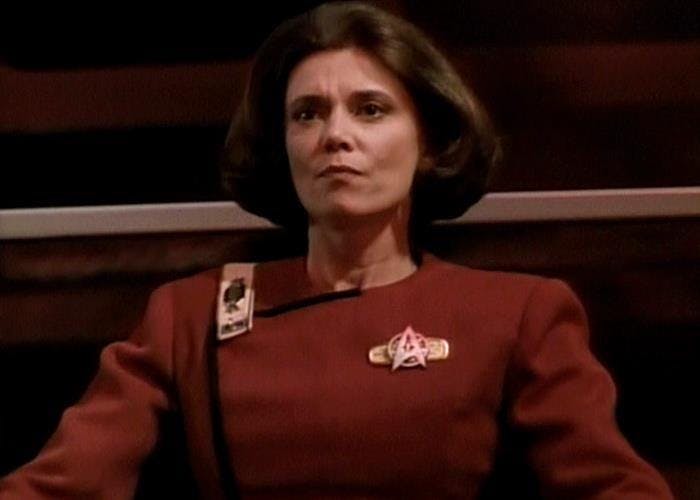
We met Garrett when her ship, the Enterprise -C, came through a rift in the space-time continuum in the middle of a battle with the Romulans and changed The Next Generation timeline (“ Yesterday’s Enterprise ”). Even badly injured, Garrett refused to leave the Bridge of her ship before getting answers about the well-being of her crew and the state of the battle.
Garrett wasn’t very fleshed out as a character. Nevertheless, her determination, self-sacrifice, and dedication to her ship earned her a pointed moment of respect from Captain Picard; a symbolic acknowledgement of character traits that would later be present in abundance when producers finally pulled out the big chair for Janeway.
Commander Elizabeth Shelby (Elizabeth Dennehy, 1991)
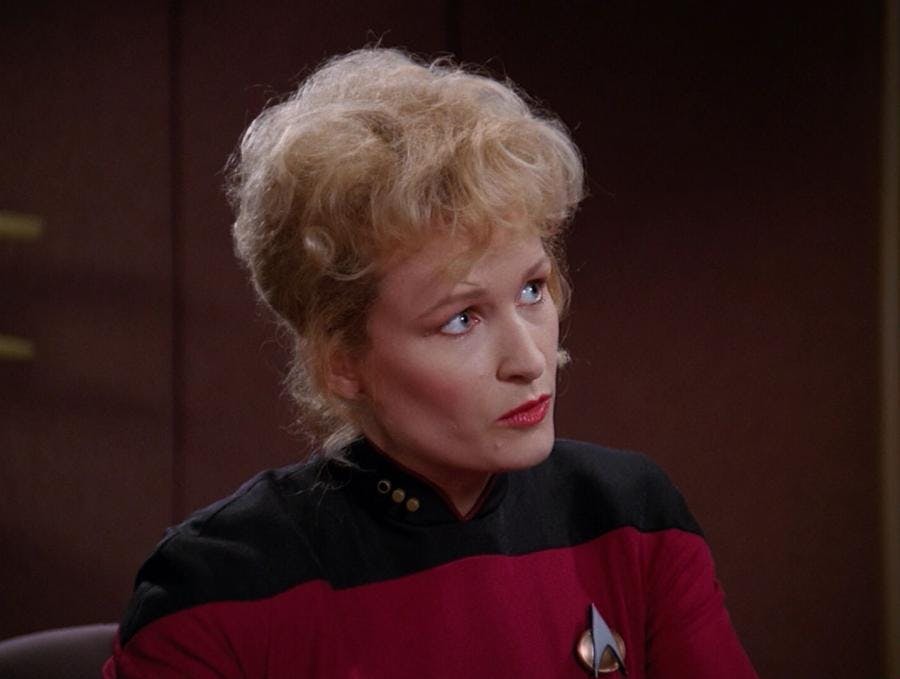
“Damn, you’re ambitious, Shelby .” Acting-Captain Riker’s words to the hotshot young commander were emblematic of her core character trait (“ The Best of Both Worlds ”). Shelby knew she deserved to be in charge thanks to her extraordinary competence, knowledge of the Borg, and grace under pressure. Her mentor, Admiral Hanson, admired her for her skill and energy, but also admitted to Picard that she featured in a gross “old man’s fantasies.”
This latter statement exemplified a thread that ran through the presentation of multiple women in positions of command, including Janeway herself — the writers had to find a way to remind the viewer that the character was still a woman, no matter how many pips were on her collar. In this case, they did it by making Shelby the object of her mentor’s lust.
Admiral Alynna Nechayev (Natalia Nogulich, 1992)
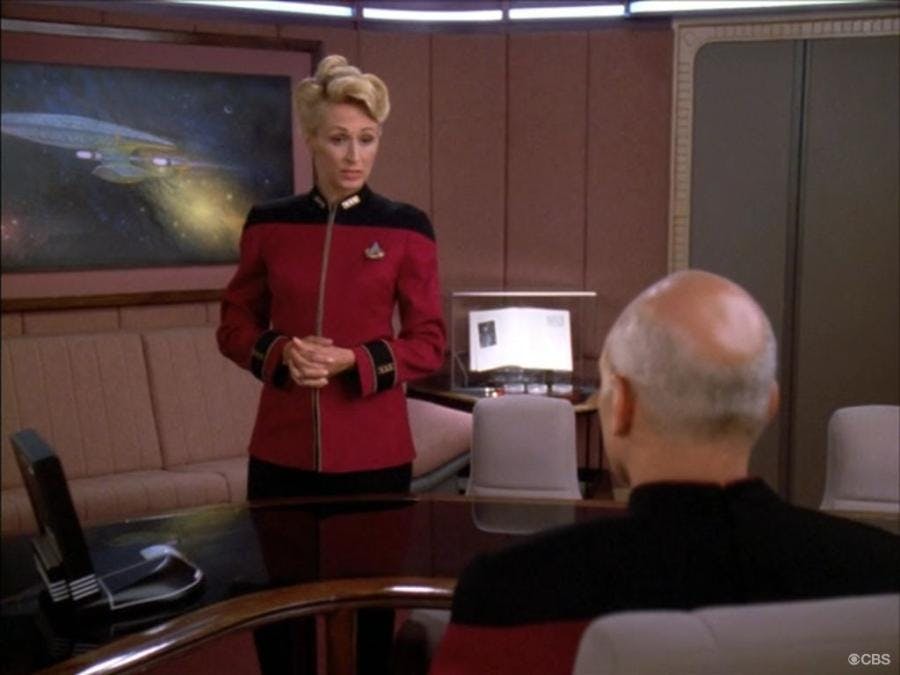
The counterpoint to Satie in every way, Nechayev is all steady, flinty competence. She was originally written to be “dark skinned,” which would have been terrific, but then ultra-blonde Nogulich was offered the part and the rest is history. We first met Nechayev when she came aboard the Enterprise in The Next Generation to take Picard’s command away from him (“ Chain of Command ”). Her lack of concern with being liked continued when she dressed Picard down for not committing genocide against the Borg (“ Descent ”). The writers eventually softened her relationship with Picard (as always, reminding us that she’s a woman after all) when he replicated her favorite canapés and she admitted that they’re “extremely fattening” (“ Journey’s End ,” “ Preemptive Strike ”).
Nevertheless, she continued to nettle the men under her command. Her relationship with Captain Sisko on Deep Space Nine was famously testy because, in his mind, her perspective was too Federation-centric, which made her ignorant of the realities faced by those living on the edges of Cardassian space (“ The Maquis ”).
Colonel Kira Nerys (Nana Visitor, 1993)
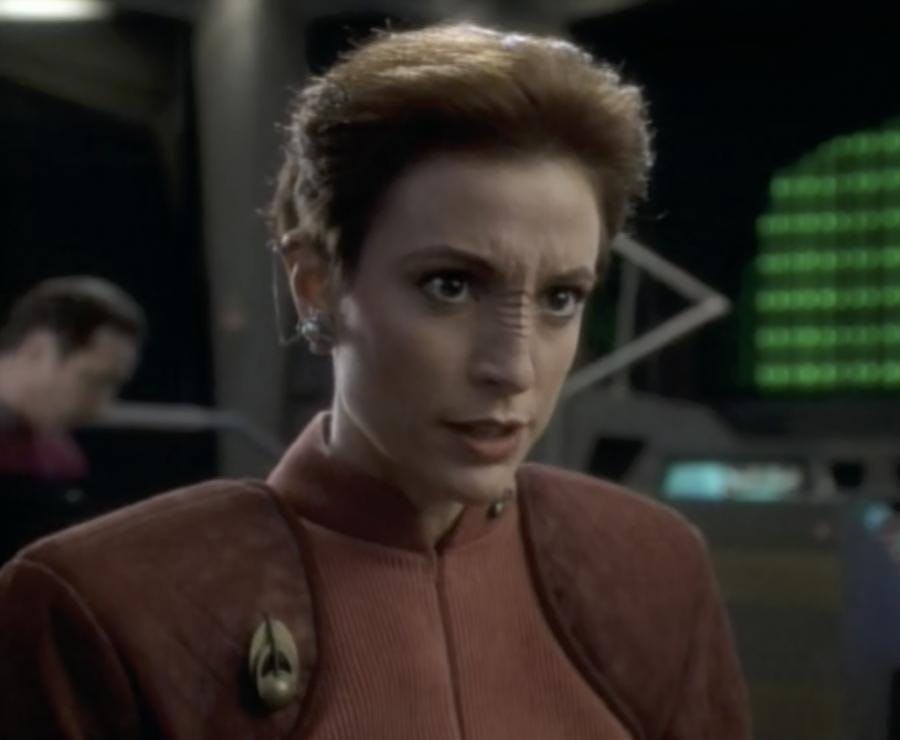
It takes a special kind of person to pivot from guerilla resistance fighter to able politician, but Kira Nerys proved up to the challenge. At first unsure of herself in her new post-Cardassian occupation role on Deep Space 9 (“ Emissary ,” “ Past Prologue "), Kira matures into an able stateswoman (“ The Homecoming ,” “ The Circle ,” “ The Siege ”).
Another notable feature of Kira’s character is that we see her in multiple romantic relationships throughout the course of the series, but she is never defined or subsumed by these partnerships (“ Life Support ,” “ Shakaar ,” “ His Way ”).
Her passion and sometimes single-minded commitment to Bajoran independence and Cardassian accountability for the occupation lead her down dangerous paths on more than one occasion (“Past Prologue,” “ Duet ,” “ Second Skin ”) but by the end of the series, Kira comes come full circle by aiding her Cardassian former enemies as they struggle to retake their homeworld from the Dominion (“ What You Leave Behind ”).
Captain Kasidy Yates (Penny Johnson Jerald, 1995)
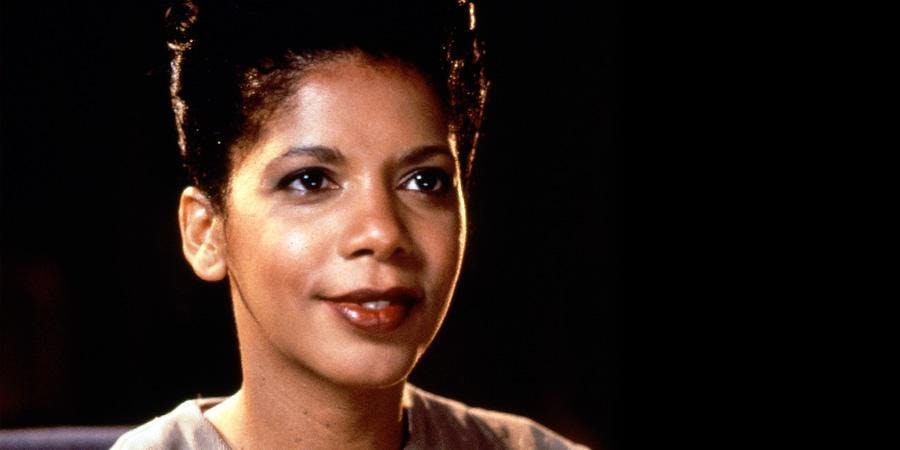
Yates was not technically introduced until a few months after Voyager premiered, but her inception paralleled Janeway’s and it was more important to have at least one Black woman on this list than to quibble over a few months’ difference in airdates.
Reserved and rigorously self-sufficient, Yates’ non-Starfleet status gave the writers an opportunity to afford her moral ambiguities they never would have given to a woman captain otherwise. She collaborated with the Maquis rebellion by using her freighter to deliver food and medical supplies to them in the Badlands and spent six months in a Federation penal colony (“ For the Cause ”).
Yates and Captain Sisko bonded over a shared love of baseball (“ Family Business ,” “ Take Me Out to the Holosuite ”) and, after dating for several seasons, decide to marry despite a warning from the Prophets that they would experience great sorrow if they chose to tie their lives together (“ Til Death Do Us Part ”).
Being the wife of the Emissary was not easy for Yates. She was livid after Sisko called in a favor from the Bajoran Freight and Shipping Authority to have her sidelined as the Dominion War escalated (“ The Changing Face of Evil ”). Yates set Sisko straight in a hurry and went back to work; but she was thrown by the fact that many of her Bajoran crew — people she had known for years — suddenly asked her for spiritual guidance now that she was married to the Emissary (“ Strange Bedfellows ”).
When last we saw Yates, she was left behind as a pregnant newlywed, comforting Jake Sisko as they both grieved Captain Sisko’s sudden departure to be with the Prophets. We never did find out whether her husband came back into her life, but we do know that she prospered as the owner-operator of Kasidy Yates Interstellar Freights (“ Remembrance ,” Picard ).
Honorable Mentions
Kai winn adami (louise fletcher, 1994).
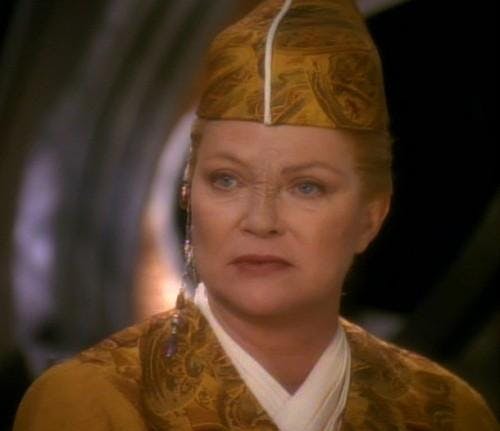
What would Deep Space Nine have been without a conniving, ambitious, hypocritical foil to the Emissary? Winn became Kai more out of political savvy than spiritual leadership (“ The Collaborator ”). The Prophets rejected her and she rejected them in turn (“ Strange Bedfellows ,” “ What You Leave Behind ”). She abused her power, murdered her assistant, and had sex with her mortal enemy before using him as a sacrificial lamb. Her only redeeming act was her final one, when she gave Sisko the knowledge he needed to defeat a re-animated Dukat before she was consumed by flames.
The Female Changeling (Salome Jens, 1994)
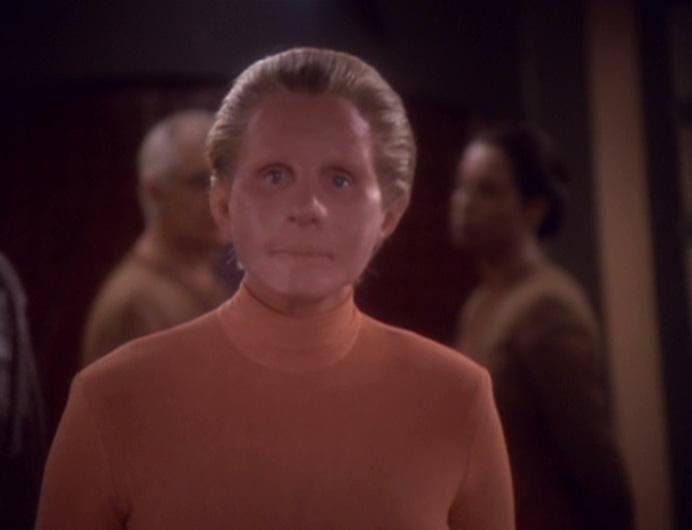
One might imagine that gender would be constructed in a non-binary fashion among a species where form is mutable; but being a creature of the nineties and having only two options, this particular Changeling chose to be a woman in her humanoid form on Deep Space Nine (“ The Search "). As to her performance of gender? She was a villain and therefore producers didn’t care about making her likable. This allowed her to be vindictive, genocidal, and bent on fighting her war on the Alpha Quadrant down to the last man — that is until an Odo-ex-machina cured her of the Section 31 disease and convinced her to surrender and stand trial for her crimes in exchange for his promise to return to the Great Link (“ What You Leave Behind ”).
Lieutenant Natasha Yar (Denise Crosby, 1987)
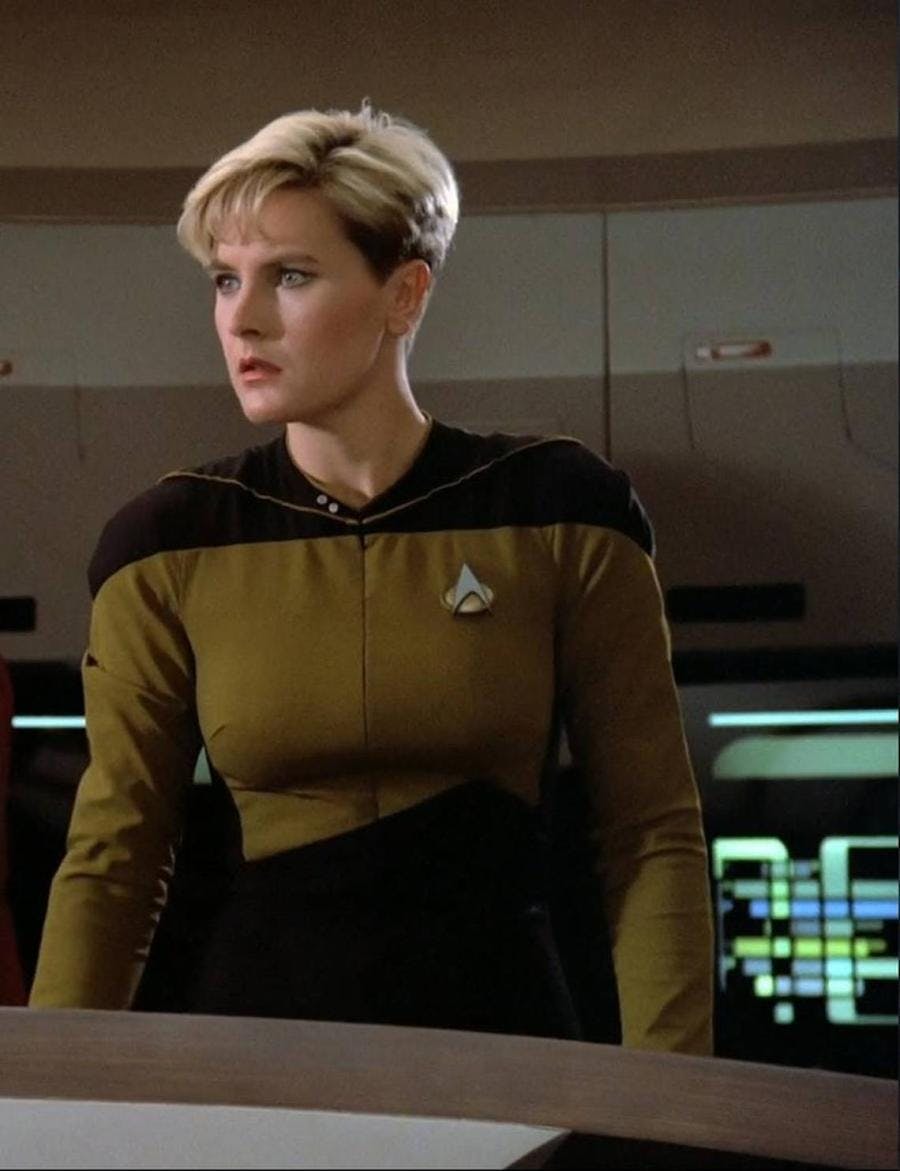
Yar was in charge of the Enterprise ’s entire Security department, but since we only got her for 23 episodes, we didn’t really have a chance to see her explore her position of authority or the complications of command in the same way we did with Troi and Crusher in the later seasons of The Next Generation .
The Admirals
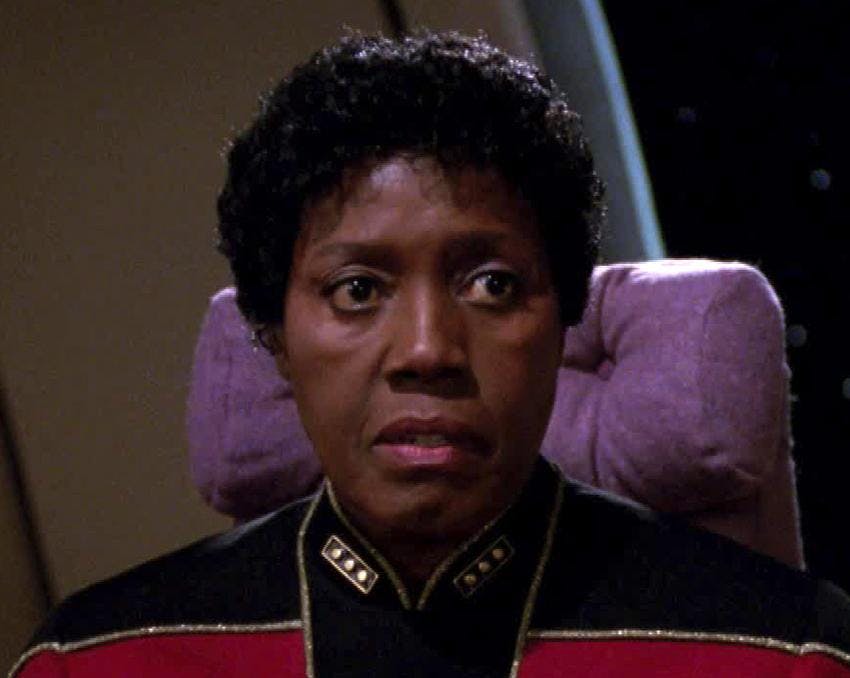
Shanthi . Hayes. Blackwell . We only saw them in passing viewscreen conversations or heard them referenced in conversation, but the implication was clear that there were women leaders all over the Federation just not in the setting we were watching.
It is interesting to note that, while we learn that Uhura was eventually promoted to the role of Admiral, we never saw her issue orders or make command decisions. It is also interesting to note that, when last we saw her, Janeway herself had become an admiral, seen briefly on Picard’s ready room viewer when she orders the Enterprise to Romulus in Star Trek: Nemesis .
This article was originally published on June 18, 2020.
Tae Phoenix (she/her) is a singer-songwriter, culture jammer, and community organizer from Seattle, WA. Her hobbies include obsessing over Star Trek and yelling at drivers to get out of the bike lane. You can find her at @taephoenix almost anywhere your personal data is being sold or at taephoenix.com.
Stay tuned to StarTrek.com for more details! And be sure to follow @StarTrek on Facebook , Twitter , and Instagram .
Get Updates By Email
- Cast & crew
- User reviews
- Episode aired Oct 4, 1988

Capt. Pike is held prisoner and tested by aliens who have the power to project incredibly lifelike illusions. Capt. Pike is held prisoner and tested by aliens who have the power to project incredibly lifelike illusions. Capt. Pike is held prisoner and tested by aliens who have the power to project incredibly lifelike illusions.
- Robert Butler
- Gene Roddenberry
- Jeffrey Hunter
- Susan Oliver
- Leonard Nimoy
- 70 User reviews
- 9 Critic reviews
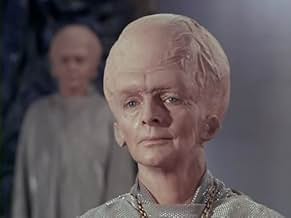
Top cast 32

- Captain Christopher Pike

- (as M. Leigh Hudec)

- Dr. Phillip Boyce

- Lt. José Tyler
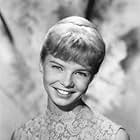
- Yeoman J.M. Colt
- Columbia Survivor
- (uncredited)
- Bridge Crewmember

- Transporter Chief Pitcairn

- Third Survivor
- First Talosian

- Dr. Theodore Haskins
- Enterprise Geologist
- All cast & crew
- Production, box office & more at IMDbPro
Did you know
- Trivia Leonard Nimoy 's Mr. Spock was the only character from the first pilot retained into the series. The ship's first officer character, Number One, was rejected for the series by the network because she was female (according to Gene Roddenberry ), or because of her lack of acting ability (according to Desilu production chief Herbert F. Solow ). Actress Majel Barrett (Roddenberry's girlfriend at the time and later wife) was recast as Nurse Chapel. When the pilot was recycled as The Menagerie: Part I (1966) and The Menagerie: Part II (1966) , it was established that Captain Pike's voyage to Talos IV took place 13 years prior to the events of the Star Trek (1966) series.
- Goofs As Pike retreats up the stairs from the warrior on "Rigel VII", you can see the blade of his spear bend as it pushes against the warrior's chest.
Captain Christopher Pike : The point is that this isn't the only life available. There's a whole galaxy of things to choose from.
Dr. Boyce : Not for you. A man either lives life as it happens to him, meets it head-on and licks it, or he... turns his back on it and starts to wither away.
Captain Christopher Pike : Now you're beginning to talk like a doctor, bartender.
Dr. Boyce : Take your choice. We both get the same two kinds of customers - the living... and the dying.
- Alternate versions Special Enhanced version Digitally Remastered with new exterior shots and remade opening theme song
- Connections Edited into Star Trek: The Menagerie: Part I (1966)
- Soundtracks Star Trek Theme (Original TV Series Version) (uncredited)
User reviews 70
- timdalton007
- Jun 16, 2009
- October 4, 1988 (United States)
- United States
- Official site
- Paramount Pictures (United States)
- Star Trek the Original Series: The Cage
- Desilu Studios - 9336 W. Washington Blvd., Culver City, California, USA (Studio)
- Desilu Productions
- See more company credits at IMDbPro
Technical specs
- Runtime 1 hour 3 minutes
Related news
Contribute to this page.

- See more gaps
- Learn more about contributing
More to explore
Recently viewed.
- Phototrophs
- Races of the Milky Way Galaxy
- Dioecious Species
- Spacefaring Civilizations
- 1966 Debuts
- Aliens Portrayed by James Doohan
- Aliens Portrayed by William O'Connell
- Aliens Portrayed by Lani Minella
- Live Action Species
- Animated Species
- Bipedal Species
- Species with Binocular Vision
- Pherokinetic Species
- Enslaved Species
- Genetically compatible with Humans
- Literary Species
- Comic Species
Orion (Star Trek)
- 3 Canon appearances
- 4 Non-canon info
History [ ]
Orion females are known through the galaxy for their beauty and for releasing strong pheromones which make their attraction particularly hard to resist. In at least some occasions, the Orions have been able to take advantage of this to persuade others to do what they want. Orions are a cunning, dangerous and opportunistic species, frequently found involved with conspiracy, piracy and slavery of other species as well as their own. Up until the 23rd century, they tried hard to hide their criminal activities and present themselves as politically neutral. Orion pirates would go to the extreme of committing both murder and suicide in order to maintain the faux image of neutrality of their species.
This apparently changed after the failed incidents on way to the Babel Conference in "Journey to Babel", in which an Orion spy masquerading as an Andorian murdered the Tellarite ambassador in an attempt to prevent Coridan from joining the Federation; so that the Orions could continue to commercially exploit that planet. Decades later, the illegal activities of the Orions had become well known, and the Orion Syndicate was openly acknowledged as one of the most powerful and feared criminal organizations in the Quadrant. Dialogue from a few episodes (e.g. TOS - "What Are Little Girls Made Of"; TAS - "Yesteryear") appears to suggest that the Orion civilization was (possibly still is) a prosperous, scientifically advanced society.
It is further possible that, at least in the scientific field they have a nice relationship with other species; since an episode of Voyager makes mention of the Orion Institute of Cosmology which accepts Human students. At least for the 22nd century, the Orions operated in an area of space adjacent to the Klingon Empire.
In the mirror universe, they were one of the species conquered by the Terran Empire. In the alternative timeline introduced in J. J. Abrams' Star Trek quasi-reboot film it appears that Orions have somehow become members of the Federation.
Gallery [ ]
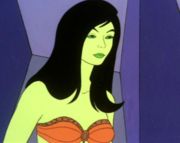
Canon appearances [ ]
- "The Cage" (actually an illusion)
- "The Menangerie, Part II" (flashback from "The Cage")
- "Journey to Babel" (disguised as an Andorian)
- "Whom Gods Destroy"
- "The Time Trap"
- "The Pirates of Orion"
- "Borderland"
- "In a Mirror, Darkly, Part II"
- Star Trek (2009 film)
Non-canon info [ ]
Non-canonical works set in the Star Trek universe have greatly expanded what is known about the Orion race, making such interesting claims as to the existence of several other color varieties other than green; the idea that the Orions would often absorb other humanoid species with their own within a single government; that Orion blood could be either orange or green and copper-based much like that of Vulcans ; and that their cells contain chlorophyll (indicating that they either are or evolved from phototrophic lifeforms) and are able to absorb light in the ultraviolet spectrum, which is consistent with the most well known stars in the Orion Belt being huge blue stars which emit highly energetic radiation.
- 1 Xenomorph
- 3 Pleiadian
Screen Rant
Star trek: every female captain (so far).

Your changes have been saved
Email is sent
Email has already been sent
Please verify your email address.
You’ve reached your account maximum for followed topics.
Star Trek Officially Brands a Surprising Deep Space Nine Hero as a War Criminal
Star trek accidentally created 2 of hollywood's biggest current stars, after 57 years, star trek settles the truth about trelane's godlike species.
Although the Star Trek franchise has been largely dominated by male captains, the list of women who have attained the rank is a lot longer than people might expect. The franchise began with Star Trek: The Original Series in 1966, depicting a vision of the future where humanity had overcome its problems as become part of a galactic power that was founded on peace and exploration. In keeping with this utopian future, every Star Trek series has consistently strived for diversity, including showing women in high-ranking positions within Starfleet.
When considering female captains in Star Trek , many fans will immediately jump to Captain Kathryn Janeway , the main character of Star Trek: Voyager and the woman that is widely considered to be the "first" female captain in the franchise. It is true that the character was the first woman to head up a Star Trek series since the role of the main character was previously held by men in every other show. However, contrary to popular belief, Janeway was not technically the first female captain.
Related: Star Trek: Voyager Originally Had A Different Captain Janeway
Prior to Voyager , several important female captains were included in various Star Trek series and movies, and the franchise did not stop depicting them after Voyager ended . To date, there have been 12 important female captains that have played pivotal roles in the franchise. However, it should be noted that many more have been referenced in writing or in dialogue while not being shown directly on the screen.
Captain Of The USS Saratoga
Although never given a name, the Captain of the USS Saratoga in Star Trek IV: The Voyage Home was the franchise's very first female captain. The Voyage Home was the 4th of 6 movies produced about the cast of The Original Series and is widely regarded as one of the greatest movies in the Star Trek franchise . The Captain of the Saratoga had a brief but memorable role towards the beginning of the film where she and her crew became some of the first victims of the main antagonist, an alien probe heading towards Earth. The Captain was played by actress Madge Sinclair, who would go on to play the role of another female captain that will be discussed later on.
Captain Phillipa Louvois
Star Trek: The Next Generation kicked off its list of female captains in season 1 with Captain Phillipa Louvois. Played by actress Amanda McBroom, Louvois was featured in the classic TNG episode "The Measure of a Man," where she served as the judge in Lieutenant Commander Data's sentience trial against Bruce Maddox. Louvois was implied to have had a previous romantic relationship with Captain Jean-Luc Picard, although this was never confirmed. Interestingly, Louvois is also one of the very few staff captains depicted in Star Trek , meaning that she was not in active command of a starship, instead serving Starfleet in another capacity as part of the Judge Advocate General's office.
Captain Tryla Scott
Although she was only featured briefly in the TNG episode "Conspiracy," Captain Tryla Scott, played by Ursaline Bryant, should be remembered as an important part of Star Trek history. "Conspiracy" itself is a memorable episode, involving Captain Picard and the crew of the Enterprise-D uncovering a plot by parasitic aliens to infiltrate the highest levels of Starfleet. Captain Scott was part of a group that suspected the conspiracy was taking place, although she ultimately was taken over by one of the creatures herself. Tryla Scott was the first Black female captain shown in the franchise, and the brief backstory she was given in "Conspiracy" also detailed how she was the fastest person in Starfleet history to attain the rank of captain, making her a Star Trek legend for a variety of reasons.
Related: Star Trek: Every Captain Who Became An Admiral
Captain Rachel Garrett
Played by actress Tricia O'Neil, Captain Rachel Garrett is another often-forgotten captain who played an important role in franchise history. Captain Garrett is the only woman to ever command a version of Star Trek's most famous ship, the USS Enterprise. Garrett was captain of the Enterprise-C and was featured in the classic Star Trek: The Next Generation episode, "Yesterday's Enterprise." During the episode, the Enterprise-C's accidental time travel 22 years into the future created an alternate timeline where the Federation was involved in a long and bloody war with the Klingons . When this was discovered, Garrett agreed to pilot her ship back through the temporal rift it had come through to restore the timeline but was unfortunately killed by an attacking Klingon vessel before she could do so. Her helmsman, Richard Castillo, eventually took the ship back through and restored the timeline. Although "Yesterday's Enterprise" is an extremely popular episode among fans, Captain Garrett rarely receives the recognition she deserves as the only female captain of the Enterprise.
Captain Silva La Forge
Silva La Forge's inclusion in The Next Generation is significant for two reasons. Firstly, she was the mother of Geordi La Forge and provided some interesting context to the character's life in the season 7 episode "Interface." Unfortunately, the episode also involved her disappearance and presumed death while commanding the USS Hera, something that affected Geordi greatly and almost compromised his ability to be objective about the mission he was currently involved in. The second reason Captain La Forge is significant is that she was played by Madge Sinclair, the same actress who played the unnamed Saratoga Captain in Star Trek IV . Sinclair is the only actress to hold the distinction of playing two Black female captains on Star Trek .
Captain Kasidy Yates-Sisko
Kasidy Yates-Sisko was a recurring character on Star Trek: Deep Space Nine , and the only heavily featured female captain who was not also a member of Starfleet. She was first introduced in the season 3 episode "Family Business," and went on to become the girlfriend and later wife of Deep Space Nine's main character, Captain Benjamin Sisko . Sisko and Kasidy's relationship evolved throughout the course of 5 seasons, although it was tragically cut short in the series finale when Sisko was taken to the Celestial Temple to reside with the Bajoran Prophets. Outside of her relationship, Yates-Sisko was involved in commanding a fleet of transport freighters that were initially independent contractors but later worked for the Bajoran Ministry of Commerce. She became a popular character among fans, and her relationship with Sisko is arguably one of Star Trek's greatest romances.
Captain Benteen
Captain Benteen was featured in the Deep Space Nine episodes "Homefront" and "Paradise Lost." She was a major player in Starfleet Admiral Leyton's plot to bring about a coup d'etat. Benteen was Admiral Leyton's adjutant at the time until he promoted her to Captain and gave her command of the USS Lakota, ordering her to stop the USS Defiant from reaching Earth. Captain Sisko, in command of the Defiant, had information that Leyton had been manufacturing evidence of a Changling threat in Starfleet in order to take over the organization. Luckily, Benteen listened to Sisko, and after being convinced of Leyton's treachery she helped defeat him and stop the coup from happening. Benteen was played by actress Susan Gibney, who was a recurring Star Trek player, having also portrayed the character of Leah Brahms on Star Trek: The Next Generation .
Related: Star Trek: What Happened To All 4 Starships Named Defiant
Captain Lisa Cusak
Captain Lisa Cusak was the focus of the popular Deep Space Nine episode "The Sound of Her Voice." She was never shown on screen and was only heard through voiceover for the majority of the episode. Cusak's ship, the USS Olympia, crashed on a planet in the Beta Quadrant in 2371, leaving her as the only survivor. Because of the metreon radiation surrounding the planet, Cusak's distress call was unknowingly transmitted 3 years into the future, where it was received by the crew of Deep Space 9 onboard the USS Defiant. The Defiant established two-way communication with Cusak, unknowingly transmitting their messages back in time as they rushed to rescue her. Once they had reached the planet, however, they discovered what had happened, and decided to take Cusak's body back to the station to hold a funeral for her, feeling that she had left a great impression on their lives even a short time. Cusak was voiced by actress Debra Wilson.
Captain Kathryn Janeway
As previously discussed, Captain Janeway, played by actress Kate Mulgrew, was the first female captain to also be the lead on her own show. Star Trek: Voyager , which ran from 1995 to 2001, helped make Janeway an inspiration to many female Star Trek fans. As captain, Janeway guided her crew through the Delta Quadrant after the ship was stranded there because of a life form called the Caretaker. During Voyager's run, Janeway proved herself to be a tough, smart captain who was fiercely protective over her crew. Fans of Voyager were ecstatic to learn recently that Mulgrew will be reprising her role as Janeway in the upcoming animated series Star Trek: Prodigy , which will debut on Paramount+ and be geared towards a younger audience.
Captain Hernandez
Captain Hernandez was a female Starfleet captain featured on Star Trek: Enterprise . She was first introduced in the season 4 episode "Home" as the captain of the Columbia NX-02 and former love interest of Captain Jonathan Archer, the show's lead. Later, the character of Trip Tucker was briefly a part of Hernandez's crew when he requested a transfer off Enterprise. Hernandez and her crew were also involved in the mission to rescue Doctor Phlox from Klingon space during the Augment crisis. Star Trek: Enterprise served as a prequel to the entire franchise up until that point, and Starfleet was a much smaller operation during the show, so having one of the few featured Starfleet captains be a woman was a smart choice by the writers.
Captain Phillipa Georgiou
After a long hiatus, Star Trek: Discovery kicked off a new wave of Star Trek shows in 2017. The show also marked several more strides forward in representation for the franchise, including the addition of two new female captains, one of which was Phillipa Georgiou. Georgiou was introduced in the pilot as the captain of the USS Shenzhou and commanding officer of Discovery's main character, Michael Burnham. Captain Georgiou's life was cut short by the start of the Klingon War when she was killed by T'Kuvma during the Battle of the Binary Stars. Fortunately for actress Michelle Yeoh, however, the character was brought back later in the season, this time as Emperor Georgiou, Captain Georgiou's Mirror Universe counterpart. Emperor Georgiou served as a recurring character for the majority of Discovery's 3 seasons and is supposedly set to star in her own show sometime in the near future.
Related: Star Trek Theory: Where & When Emperor Georgiou's Section 31 Spinoff Is Set
Captain Michael Burnham
Star Trek: Discovery's other addition to the list of female captains is Captain Michael Burnham , who only recently attained her rank. Burnham did not start off as captain, much like Star Trek's other Black series lead, Benjamin Sisko. The road to the Captain's chair was a hard one for Burnham, who began the first season of Discovery as Starfleet's first-ever mutineer. The 3rd season's time jump to the 32nd century, however, eventually provided her the opportunity to captain the USS Discovery. With season 4 of Star Trek: Discovery expected sometime later in 2021, fans will soon get to see what kind of captain Burnham turns out to be, including how she commands Star Trek's first all-female bridge crew.
It is interesting to note that many of the women on Star Trek's list of female captains are women of color, showing that the franchise's diversity ideals have been and continue to be an important part of storylines. Additionally, there have been many female characters who have held a higher rank, such as Admiral Nechayev from Star Trek: TNG or Admiral Cornwell from Star Trek: Discovery . Although the franchise has at to have many female captains who are the main characters of their own shows, Star Trek still boasts an impressive list of women who have contributed meaningfully to Starfleet's female leadership.
More: Star Trek: Discovery Season 4 Will Have The First-Ever All-Female Bridge
- SR Originals
- Star Trek: Discovery

IMAGES
VIDEO
COMMENTS
Star Trek. aliens. Star Trek is a science fiction media franchise that began with Gene Roddenberry 's launch of the original Star Trek television series in 1966. Its success led to numerous films, novels, comics, and spinoff series. A major motif of the franchise involves encounters with various alien races throughout the galaxy.
The Star Trek franchise's most popular aliens are arguably the Klingons, but the mythos around them can be confusing because of all the changes they have gone through over the years. Klingons have been a staple Star Trek alien ever since Star Trek: The Original Series, with their history, culture, and politics explored extensively in both the Star Trek television shows and movies.
Cheronians. As far as we know, the people of Cheron are completely extinct. Split by a violent racial divide, the Cheronians went completely extinct as of the Star Trek: The Original Series episode "Let That Be Your Last Battlefield." When the race's only two survivors — Commissioner Bele (Frank Gorshin) and Lokai (Lou Antonio) — return home to find their people wiped out by war ...
D'Vana Tendi. Thalen. Norvo Tigan. Timicin. Tosk (Star Trek) Traveler (Star Trek) Trelane. Deanna Troi. Kestra Troi.
Trouble Keeping Her Green: Creating the Orions. The Orions were among the first alien species introduced in Star Trek. A slave girl, or rather the illusion of one, was played by Susan Oliver in the ill-fated pilot episode "The Cage". The "green girl" was the creation of Fred Phillips, who also made Spock's Vulcan look for The Original ...
32) Two Tellarite nose appliances were designed and manufactured for the appearance in "Journey to Babel". (Star Trek: Aliens & Artifacts, p. 27; Star Trek: The Original Series Sketchbook, pp. 190-192) The appliances mainly consisted of a one-piece prosthetic appliance, which was made from foam latex and covered the central part of the actor's ...
Writer Mike Sussman sought to introduce the Orions into Star Trek: Enterprise with the episode "Anomaly", but during rewrites this was changed into a new species called the Osaarians. [20] During Manny Coto's tenure as show runner in the fourth season, the Orions were re-introduced on screen for the first time since The Original Series in the episode "Borderland" in 2004, which was the first ...
An Andorian make-up test for The Motion Picture. In either the original Star Trek series or Star Trek: The Motion Picture, makeup artist Fred Phillips - who worked on both productions - tested Andorian antennae and blue facial makeup on his daughter, Janna Phillips.(The Making of Star Trek: The Motion Picture, p. 140) The first significant change in the Andorians' appearance came in The ...
Background information []. The ancient humanoid in the recorded message was played by Salome Jens, who later played the Female Changeling on Star Trek: Deep Space Nine.. In the final draft of the script, she was described as "a humanoid - in fact, one of the coolest humanoids we've ever seen, with a face wise and tragic and light-hearted all at once. ...
Mary Cheiffo's riveting performance as L'Rell illustrates a woman's rise to power in a role previously dominated by men. During Virtual Trek Con's "The Influence of Strong Women in Star Trek" panel, Chieffo compares L'Rell to other historical rulers like Queen Elizabeth I and Hatshepsut, who had to navigate a male dominated society.
By Any Other Name: Directed by Marc Daniels. With William Shatner, Leonard Nimoy, DeForest Kelley, Warren Stevens. Galactic alien scouts hijack the Enterprise for a return voyage to their home galaxy and a prelude to invasion. Kirk's only advantage is that they're not fully adapted to the human form they've taken on.
Star Trek was revived with the sequel series "Star Trek: The Animated Series" (1973-1974), which used much of the main cast from the original series. Barrett voiced two of the series' main female characters, Christine Chapel and M'Ress. The new character M'Ress was depicted as a female alien in feline form, who served as an officer on the ...
Roylan. First appearance: Star Trek (2009) So far, the rebooted Trek films have not really given funs much by way of alien species. The only classic races to get good screen time in the reboots ...
The Empath: Directed by John Erman. With William Shatner, Leonard Nimoy, DeForest Kelley, Kathryn Hays. Trapped in an alien laboratory, Kirk, Spock and McCoy meet an empath and are involved in a series of experiments.
While preparing scripts for the first season of Star Trek: The Next Generation, the idea of the Ferengi was devised by Gene Roddenberry and Herbert Wright. [2] The new alien species initially appeared in the first season's fourth episode, "The Last Outpost", which was based on a story by Richard Krzemien and a teleplay by Wright. [3]In this story, the USS Enterprise-D—whose crew are the main ...
Nichelle Nichols - Nyota Uhura. Nichols portrayed Nyota Uhura in Star Trek: The Original Series and it's film sequels. Her addition to the show's cast was seen as being very groundbreaking for African American actresses on American TV at the time. She was born in Robbins, Illinois, on December 28, 1932.
Star Trek has introduced an incredible cast of truly amazing women throughout its nearly 60-year history. In the utopian future of Star Trek, women can climb the ranks of Starfleet to achieve the same positions of authority as their male counterparts.While this ideal was somewhat hindered by the landscape of the 1960s, modern Star Trek fully embraces Gene Roddenberry's vision of a peaceful ...
Background information [] Origins []. The Talosians were the first aliens encountered on Star Trek, appearing in the earliest Star Trek: The Original Series production, "The Cage". (While Spock was the first non-Human featured, his species is not mentioned in that episode.). Upon devising the Talosians, Gene Roddenberry reused elements of the species from a story outline he submitted for an ...
The Romulan Commander(Joanne Linville, 1968) StarTrek.com. When a seemingly-unstable Captain Kirk takes the Enterprise into the Neutral Zone (" The Enterprise Incident," Star Trek: The Original Series), he and Spock are taken prisoner by a Romulan woman Commander. When we first meet her, she's fully clothed and visibly older (Linville was ...
The Cage: Directed by Robert Butler. With Jeffrey Hunter, Susan Oliver, Leonard Nimoy, Majel Barrett. Capt. Pike is held prisoner and tested by aliens who have the power to project incredibly lifelike illusions.
The Orions are a green-skinned humanoid species who inhabit the Pi3 Orionis system. Their external appearance is similar to Humans, except for the skin color, which can range from pale to dark green and, in some cases, greenish blue. Orion females are known through the galaxy for their beauty and for releasing strong pheromones which make their attraction particularly hard to resist. In at ...
Star Trek: Every Female Captain (So Far) Although the Star Trek franchise has been largely dominated by male captains, the list of women who have attained the rank is a lot longer than people might expect. The franchise began with Star Trek: The Original Series in 1966, depicting a vision of the future where humanity had overcome its problems ...
William Shatner as James T. Kirk, commanding officer of the USS Enterprise. Majel Barrett as Christine Chapel, medical officer. James Doohan as Montgomery Scott, chief engineer. DeForest Kelley as Leonard McCoy, chief medical officer. Nichelle Nichols as Uhura, communications officer. Leonard Nimoy as Spock, first officer and science officer.